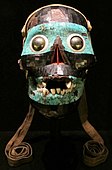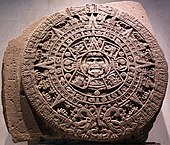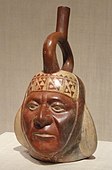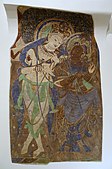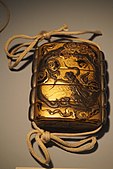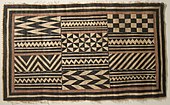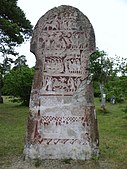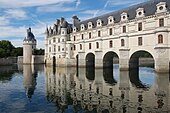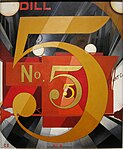History of art
This is Wikipedia's current article for improvement – and you can help You can discuss how to improve it on its talk page and ask questions at the help desk or Teahouse. See the cheatsheet, tutorial, editing help and FAQ for additional information. Editors are encouraged to create a Wikipedia account and place this article on their . |
- A dun horse from the Lascaux cave paintings
- The Venus of Brassempouy
- The Venus de Milo by Alexandros of Antioch
- Les Demoiselles d'Avignon by Pablo Picasso
- The Mona Lisa by Leonardo da Vinci
- The mask of Tutankhamun
| History of art |
|---|
The history of art focuses on objects made by humans for any number of spiritual, narrative, philosophical, symbolic, conceptual, documentary, decorative, and even functional and other purposes, but with a primary emphasis on its aesthetic visual form. Visual art can be classified in diverse ways, such as separating fine arts from applied arts; inclusively focusing on human creativity; or focusing on different media such as architecture, sculpture, painting, film, photography, and graphic arts. In recent years, technological advances have led to video art, computer art, performance art, animation, television, and videogames.
The history of art is often told as a chronology of masterpieces created during each civilization. It can thus be framed as a story of high culture, epitomized by the Wonders of the World. On the other hand, vernacular art expressions can also be integrated into art historical narratives, referred to as folk arts or craft. The more closely that an art historian engages with these latter forms of low culture, the more likely it is that they will identify their work as examining visual culture or material culture, or as contributing to fields related to art history, such as anthropology or archaeology. In the latter cases, art objects may be referred to as archeological artifacts.
Prehistory[]

Prehistoric art includes a broad range of art made by illiterate cultures, including some of the earliest human artifacts. The best-known Prehistoric artworks are the large Paleolithic cave paintings that depict animals in continental Europe, particularly the ones at Lascaux in the Dordogne region of France. Several hundread decorated caves are known, spanning the Upper Paleolithic period (c. 38,000-12,000 BC). There are examples in Ukraine, Italy and Great Britain, but most of them are in France and Spain. Many theories have been suggested about the art's purpose, the most accepted being that it was part of religious rituals, possibly to evoke hunting success.
Besides cave painting, in various parts of the world, especially in Europe, small prehistoric statuettes known as Venus figurines with exaggerated breasts and bellies were made, the famous one being Venus of Willendorf, found in Austria. Most have small heads, wide hips, and legs that taper to a point. Arms and feet are often absent, and the head is usually small and faceless.[2][3]
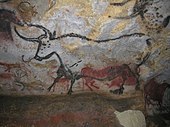
Detail in the Hall of the Bulls; c. 18,000-15,000 BC; pigments on rock; Lascaux caves (Montignac, Dordogne, France)[6]
Bison Licking Insect Bite; c. 15,000-13,000 BC; antler; legth: 10.5 cm; (Les Eyzies-de-Tayac-Sireuil, France)[5]
Antiquity[]
Mesopotamia[]

Southern Iraq in the 4th millennium BC witnessed the emergence of the first cities and the earliest form of writing. Ancient Mesopotamia covers present-day Iraq, and parts of Syria and Turkey. Because the region is situated within the Tigris–Euphrates river delta, numerous civilizations lived here, notably Sumer, Akkad, Assyria and Babylonia. The earliest writing developed here, as one of several administrative technologies that also included the cylinder seal.[8]Mesopotamian architecture was characterized by the use of bricks, lintels, and cone mosaic. Notable examples are the ziggurats, large temples in the form of step pyramids. The tomb was a chamber covered with a false dome, as in some examples found at Ur. There were also palaces walled with a terrace in the form of a ziggurat, where gardens were an important feature. The Hanging Gardens of Babylon was one of the Seven Wonders of the Ancient World.
Relief sculpture was developed in wood and stone. Sculpture depicted religious, military, and hunting scenes, including both human and animal figures. In the Sumerian period, small statues of people were produced. These statues had an angular form and were produced from colored stone. The figures typically had bald head with hands folded on the chest. In the Akkadian period, statues depicted figures with long hair and beards, such as the stele of Naram-Sin. In the Amorite period (or Neosumerian), statues represented kings from Gudea of Lagash, with their mantles and a turbans on their heads, and their hands on their chests. During Babylonian rule, the stele of Hammurabi was important, as it depicted the great king Hammurabi above a written copy of the laws that he introduced. Assyrian sculpture is notable for its anthropomorphism of cattle and the winged genie, which is depicted flying in many reliefs depicting war and hunting scenes, such as in the Black Obelisk of Shalmaneser III.[9]

The Statue of Ebih-Il; c. 2400 BC; gypsum, schist, shells, lapis lazuli; height: 52.5 cm; Louvre
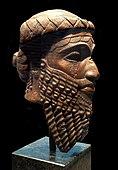
King of Akkad; c. 2250 BC; copper alloy; height: 30 cm; Iraq Museum (Baghdad, Iraq)[8]
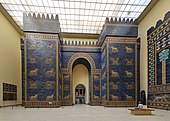
Reconstruction of the Ishtar Gate; c. 605-539 BC; glazed bricks; Pergamon Museum (Berlin, Germany)[10]

Lamassu; c. 883–859 BC; gypsum alabaster; height 311.2 cm; Metropolitan Museum of Art (New York City)
Egypt[]
One of the first great civilizations arose in Egypt, which had elaborate and complex works of art produced by professional artists and craftspeople. Egypt's art was religious and symbolic. Given that the culture had a highly centralized power structure and hierarchy, a great deal of art was created to honour the pharaoh, including great monuments. Egyptian art and culture emphasized the religious concept of immortality. Later Egyptian art includes Coptic and Byzantine art.
The architecture is characterized by monumental structures, built with large stone blocks, lintels, and solid columns. Funerary monuments included mastaba, tombs of rectangular form; pyramids, which included step pyramids (Saqqarah) or smooth-sided pyramids (Giza); and the hypogeum, underground tombs (Valley of the Kings). Other great buildings were the temple, which tended to be monumental complexes preceded by an avenue of sphinxes and obelisks. Temples used pylons and trapezoid walls with hypaethros and hypostyle halls and shrines. The temples of Karnak, Luxor, Philae and Edfu are good examples. Another type of temple is the rock temple, in the form of a hypogeum, found in Abu Simbel and Deir el-Bahari.
Painting of the Egyptian era used a juxtaposition of overlapping planes. The images were represented hierarchically, i.e., the Pharaoh is larger than the common subjects or enemies depicted at his side. Egyptians painted the outline of the head and limbs in profile, while the torso, hands, and eyes were painted from the front. Applied arts were developed in Egypt, in particular woodwork and metalwork. There are superb examples such as cedar furniture inlaid with ebony and ivory which can be seen in the tombs at the Egyptian Museum. Other examples include the pieces found in Tutankhamun's tomb, which are of great artistic value.[11]

The Great Pyramid of Giza (Giza, Egypt), circa 2589-2566 BC, by Hemiunu
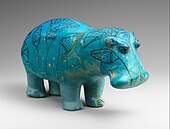
William the Faience Hippopotamus; c. 1961-1878 BC; Egyptian faience; height: 11.2 cm; Metropolitan Museum of Art (New York City)

Amenhotep III; c. 1390-1352 BC; quartzite; height: 2.49 m; Luxor Museum (Luxor, Egypt)[12]

Royal family: Akhenaten, Nefertiti and the three daughters; c. 1352–1336 BC; limestone; height: 50 cm; Egyptian Museum of Berlin (Germany)[14]

The Mask of Tutankhamun; c. 1327 BC; gold, glass and semi-precious stones; height: 54 cm; Egyptian Museum (Cairo)

The Nefertiti Bust; 1352–1336 BC; painted limestone; height: 50 cm; Neues Museum (Berlin, Germany)[14]

The well preserved The Temple of Isis from Philae (Egypt), one of the best preserved temples from ancient Egypt, 380 BC-117 AD
Indus Valley Civilization[]
Discovered in 1922, long after the contemporary cultures of Mesopotamia and Egypt, the Indus Valley Civilization, aka the Harappan Civilization (c. 2400-1900 BC) is now recognized as extraordinarily advanced, comparable in some ways with those cultures. Its sites span an area stretching from today's northeast Afghanistan, through much of Pakistan, and into western and northwestern India. Major cities of the culture include Harappa and Mohenjo-daro, located respectively in Punjab and in Sindh province in northern Pakistan, and the port city Lothal, in the state of Gujarat (India). The most numerous artefacts are square and rectangular stamp seals and seal impressions, featuring animals, usually bulls, very short Harappan texts. Many stylized terracotta figurines have also been found in Harappan sites, and a few stone and bronze sculptures, more naturalistic than the ceramic ones.[15]
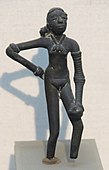
The Dancing Girl; c. 2400–1900 BC; bronze; height: 10.8 cm; National Museum (New Delhi, India)[15]

Proto-Shiva Stamp Seal; c. 2400-1900 BC; steatite; height: 3.6 cm; National Museum (New Delhi)[15]
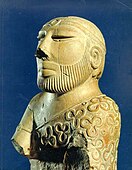
The Priest-King; c. 2400–1900 BC; steatite; height: 17.5 cm; National Museum of Pakistan (Karachi)[15]

Seal with two-horned bull and inscription; c. 2010 BC; steatite; overall: 3.2 × 3.2 cm; Cleveland Museum of Art (Cleveland, Ohio, US)
China[]
During the Chinese Bronze Age (the Shang and Zhou dynasties) court intercessions and communication with the spirit world were conducted by a shaman (possibly the king himself). In the Shang dynasty (c. 1600–1050 BC), the supreme deity was Shangdi, but aristocratic families preferred to contact the spirits of their ancestors. They prepared elaborate banquets of food and drink for them, heated and served in bronze ritual vessels. Bronze vessels were used in religious rituals to cement Dhang authority, and when the Shang capital fell, around 1050 BC, its conquerors, the Zhou (c. 1050–156 BC), continued to use these containers in religious rituals, but principally for food rather than drink. The Shang court had been accused of excessive drunkenness, and the Zhou, promoting the imperial Tian ("Heaven") as the prime spiritual force, rather than ancestors, limited wine in religious rites, in favour of food. The use of ritual bronzes continued into the early Han dynasty (206 BC–220 AD).
One of the most commonly used motifs was the taotie, a stylized face divided centrally into 2 almost mirror-image halves, with nostrils, eyes, eyebrows, jaws, cheeks and horns, surrounded by incised patterns. Whether taotie represented real, mythological or wholly imaginary creatures cannot be determined.
The enigmatic bronzes of Sanxingdui, near Guanghan (in Sichuan province), are evidence for a mysterious sacrificial religious system unlike anything elsewhere in ancient China and quite different from the art of the contemporaneous Shang at Anyang. Excavations at Sanxingdui since 1986 have revealed 4 pits containing artefacts of bronze, jade and gold. There was found a great bronze statue of a human figure which stands on a plinth decorated with abstract elephant heads. Besides the standing figure, the first 2 pits contained over 50 bronze heads, some wearing headgear and 3 with a frontal covering of gold leaf.

Standing statue of a king and shaman leader; c. 1200–1000 BC; probably bronze; total height: 2.62 m; Sanxingdui Museum (Guanghan, Sichuan province, China)

Houmuwu ding, the largest ancient bronze ever found; 1300–1046 BC; bronze; National Museum of China (Beijing)
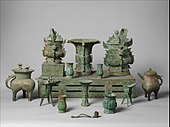
Altar set; late 11th century BC; bronze; overall (table): height: 18.1 cm, width: 46.4 cm, depth: 89.9 cm; Metropolitan Museum of Art (New York City)
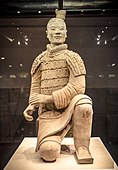
One of the warriors of the Terracotta Army, a famous collection of terracotta sculptures depicting the armies of Qin Shi Huang, the first Emperor of China
Greek[]
Even in antiquity, the arts of Greece were recognised by other cultures as pre-eminent. The Latin poet Horace, writing in the age of Roman emperor Augustus (1st century BC to 1st century AD), famously remarked that although conquered on the battlefield, "captive Greece overcame its savage conqueror and brought the arts to rustic Rome." The power of Greek art lies in its representation of the human figure and its focus on human beings and the anthropomorphic gods as chief subjects. During the Classical period (5th and 4th centuries BC), realism and idealism were delicately balanced. In comparison, work of the earlier Geometric (9th to 8th centuries BC) and Archaic (7th to 6th centuries BC) ages sometimes appears primitive, but these artists had different goals: naturalistic representation was not necessarily their aim. Roman art lover collected ancient Greek originals, Roman replicas of Greek art, or newly created paintings and sculptures fashioned in a variety of Greek styles, thus preserving for posterity works of art otherwise lost. Wall and panel paintings, sculptures and mosaics decorated public spaces and well-to-do private homes. Greek imagery also appeared on Roman jewellery, vessels of gold, silver, bronze and terracotta, and even on weapons and commercial weights. Since the Renaissance, the arts of ancient Greece, transmitted through the Roman Empire, have served as the foundation of Western art.[16]
Pre-Classical[]
Greek and Etruscan artists built on the artistic foundations of Egypt, further developing the arts of sculpture, painting, architecture, and ceramics. Greek art started as smaller and simpler than Egyptian art, and the influence of Egyptian art on the Greeks started in the Cycladic islands between 3300 and 3200 BC. Cycladic statues were simple, lacking facial features except for the nose.
The harpist, the most iconic Cycladic artwork; 2750-2200 BC; marble; height: 29.5 cm; said to be from Keros (the Cyclades); National Archaeological Museum (Athens)

Female Cycladic figurine; 2700–2600 BC; marble; height: 37.1 cm; Metropolitan Museum of Art (New York City)

Kamares ware beaked jug; 1850-1675 BC; ceramic; height: 27 cm; from Phaistos (Crete, Greece); Heraklion Archaeological Museum (Greece)

The Mask of Agamemnon, the most iconic Mycenaean artwork; 1675-1600 BC; gold; height: 25 cm, width: 27 cm, weight: 169 g; National Archaeological Museum (Athens)

The Minoan fresco named the Bull-Leaping Fresco; 1675-1460 BC; lime plaster; height: 0.8 m, width: 1 m; from the palace at Knossos (Crete); Heraklion Archaeological Museum
Minoan snake goddess; 1460-1410 BC (from the Minoan Neo-palatial Period); faience; height: 29.5 cm; from the Temple Repository at Knossos; Heraklion Archaeological Museum
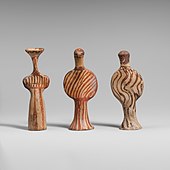
Three Mycenaean female figures; 1400-1300 BC; terracotta; heights: 10.8 cm, 10.8 cm and 10.5 cm; Metropolitan Museum of Art (New York City)

Mycenaean necklace; 1400-1050 BC; gilded terracotta; diameter of the rosettes: 2.7 cm, with variations of c. 0.1 cm, length of the pendant 3.7 cm; Metropolitan Museum of Art
Geometric[]
After the collapse of Mycenaean society, a style of Greek art emerged that illustrates clearly the break in culture and art between the Bronze Age and the ensuing Iron Age. The Protogeometric (c. 1050–900 BC) and succeeding Geometric (c. 900–700 BC) styles are characterised by their stark simplicity of decoration, as older floral and marine motifs were replaced with abstract patterns. In the new styles, pattern was rigorously applied to shape, each decorative element subordinate to but enhancing the whole. Surfaces were adorned with triangles, lines and semicircles, and concentric circles made with a multiple brush attached to a compass. The meander (Greek key) pattern was popular, as were chequerboards, diamonds, chevrons and stars. Geometric figures, whether painted or sculpted, conform to an abstract aesthetic. Although they have recognisable forms, people and animals are composed of a combination of circles, triangles and rectangles, rather than organic, realistic shapes.[17]
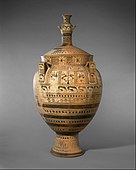
Krater with lid surmounted by a small hydria; 750-740 BC; terracotta; height: 114.9 cm; Metropolitan Museum of Art (New York City)

Krater; 750-735 BC; terracotta; height: 108.3 cm, diameter: 72.4 cm; Metropolitan Museum of Art

Statuette of a horse; 750-700 BC; bronze; overall: 11.5 × 10 × 2.6 cm; Cleveland Museum of Art (Cleveland, Ohio, US)

Statuette of a horse; c. 740 BC; bronze; height: 6.5 cm; Louvre
Classical and Hellenistic[]
The human figure remained the most significant image in Greek sculpture of the Classical period (5th and 4th centuries BC). Artists strove to balance idealised bodily beauty and increasingly realistic anatomy, imitating nature by precisely rendering the ligaments, musculature and curves of the human form.[18]
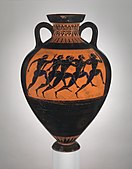
The Euphiletos Painter Panathenaic prize amphora; c. 530 BC; painted terracotta; height: 62.2 cm; Metropolitan Museum of Art (New York City)
The Artemision Bronze; 460-450 BC; bronze; height: 2.1 m; National Archaeological Museum (Athens)
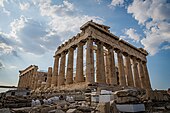
The Parthenon on the Athenian Acropolis, the most iconic Doric Greek temple built of marble and limestone between c. 460-406 BC, dedicated to the goddess Athena[19]

Mirror with a support in the form of a draped woman; mid-5th century BC; bronze; height: 40.41 cm; Metropolitan Museum of Art

Calyx-krater; 400-375 BC; ceramic; height: 27.9 cm, diameter: 28.6 cm; from Thebes (Greece); Louvre

The Grave relief of Thraseas and Euandria; 375-350 BC; Pentelic marble; height: 160 cm, width: 91 cm; Pergamon Museum (Berlin)

Volute krater; 320-310 BC; ceramic; height: 1.1 m; Walters Art Museum (Baltimore, US)

Statuette of a draped woman; 2nd century BC; terracotta; height: 29.2 cm; Metropolitan Museum of Art

Venus de Milo; 130–100 BC; marble; height: 203 cm (80 in); Louvre
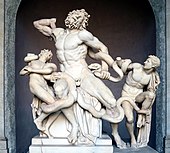
Laocoön and His Sons; early first century BC; marble; height: 2.4 m; Vatican Museums (Vatican City)

Mosaic which represents the Epiphany of Dionysus; 2nd century AD; from the Villa of Dionysus (Dion, Greece); Archeological Museum of Dion

Illustrations of examples of ancient Greek ornaments and patterns, drawn in 1874
Rome[]
Roman art is sometimes viewed as derived from Greek precedents, but also has its own distinguishing features. Roman sculpture is often less idealized than the Greek precedents, being very realistic. Roman architecture often used concrete, and features such as the round arch and dome were invented. Luxury objects in metal-work, gem engraving, ivory carvings, and glass are sometimes considered in modern terms to be minor forms of Roman art,[20] although this would not necessarily have been the case for contemporaries.
Roman artwork was influenced by the nation-state's interaction with other people's, such as ancient Judea. A major monument is the Arch of Titus, which was erected by the Emperor Titus. Scenes of Romans looting the Jewish temple in Jerusalem are depicted in low-relief sculptures around the arch's perimeter.
Ancient Roman pottery was not a luxury product, but a vast production of "fine wares" in terra sigillata were decorated with reliefs that reflected the latest taste, and provided a large group in society with stylish objects at what was evidently an affordable price. Roman coins were an important means of propaganda, and have survived in enormous numbers.

Bronze statuette of a philosopher on a lamp stand; late 1st century BC; bronze; overall: 27.3 cm; weight: 2.9 kg; Metropolitan Museum of Art (New York City)
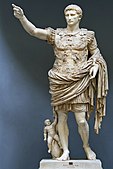
Augustus of Prima Porta; c. 20 BC; white marble; height: 2.06 m; Vatican Museums (Vatican City)

Restoration of a fresco from an Ancient villa bedroom; 50-40 BC; dimensions of the room: 265.4 × 334 × 583.9 cm; Metropolitan Museum of Art (New York City)

Altar with festoons; c. 50 AD; marble; height: 99.5 cm, width: 61.5 cm, depth: 47 cm; Louvre

The Praetorians Relief; c. 51–52; marble; 163 × 134 × 28 cm; Louvre-Lens (Lens, France)

Calyx-krater with reliefs of maidens and dancing maenads; 1st century AD; Pentelic marble; height: 80.7 cm; Metropolitan Museum of Art

Panoramic view of the Pantheon (Rome), built between 113 and 125
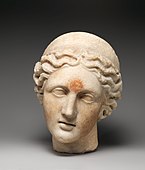
Head of a goddess wearing a diadem; 1st–2nd century; marble; height: 23 cm; Metropolitan Museum of Art
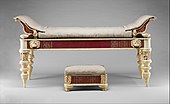
Couch and footstool; 1st–2nd century AD; wood, bone and glass; couch: 105.4 × 76.2 × 214.6 cm; Metropolitan Museum of Art
Sarcophagus with Apollo, Minerva and the Muses; c. 200 AD; from Via Appia; Antikensammlung Berlin (Berlin)

Marine mosaic (central panel of three panels from a floor); 200–230; mosaic (stone and glass tesserae); height: 2,915 mm, width: 2,870 mm; Museum of Fine Arts (Boston, US)

The Theseus Mosaic; 300–400; marble and limestone pebbles; 4.1 × 4.2 m; Kunsthistorisches Museum (Vienna, Austria)
Middle Eastern[]
Pre-Islamic Arabia[]

The art of Pre-Islamic Arabia is related to that of neighbouring cultures. Pre-Islamic Yemen produced stylized alabaster heads of great aesthetic and historic charm. Most of the pre-Islamic sculptures are made of alabaster.
Archaeology has revealed some early settled civilizations in Saudi Arabia: the Dilmun civilization on the east of the Arabian Peninsula, Thamud north of the Hejaz, and Kindah kingdom and Al-Magar civilization in the central of Arabian Peninsula. The earliest known events in Arabian history are migrations from the peninsula into neighbouring areas.[21] In antiquity, the role of South Arabian societies such as Saba (Sheba) in the production and trade of aromatics not only brought such kingdoms wealth but also tied the Arabian peninsula into trade networks, resulting in far-ranging artistic influences.
It seems probable that before around 4000 BC the Arabian climate was somewhat wetter than today, benefitting from a monsoon system that has since moved south.[citation needed] During the late fourth millennium BC permanent settlements began to appear, and inhabitants adjusted to the emerging dryer conditions. In south-west Arabia (modern Yemen) a moister climate supported several kingdoms during the second and first millennia BC. The most famos of these is Sheba, the kingdom of the biblical Queen of Sheba. These societies used a combination of trade in spices and the natural resources of the region, including aromatics such as frankincense and myrrh, to build wealthy kingdoms. Mārib, the Sabaean capital, was well positioned to tap into Mediterranean as well as Near Eastern trade, and in kingdoms to the east, in what is today Oman, trading links with Mesopotamia, Persia and even India were possible. The area was never a part of the Assyrian or Persian empires, and even Babylonian control of north-west Arabia seems to have been relatively short-lived. Later Roman attempts to control the region's lucrative trade foundered. This impenetrability to foreign armies doubtless augmented ancient rulers' bargaining power in the spice and incense trade.
Although subject to external influences, south Arabia retained characteristics particular to itself. The human figure is typically based on strong, square shapes, the fine modeling of detail contrasting with a stylized simplicity of form.

Stele of a male wearing a baldric; 4th millennium BC; sandstone; height: 92 cm; from Al-'Ula (Saudi Arabia); in a temporary exhibition in the National Museum of Korea (Seoul), named Roads of Arabia: Archaeological Treasures of Saudi Arabia

Standing female figure wearing a strap and a necklace; 3rd–2nd millennium BC; sandstone and quartzite; height: 27.5 cm, width: 14.3 cm, depth: 14.3 cm; from Mareb (Yemen); Metropolitan Museum of Art (New York City)

Incense burner; mid-1st millennium BC; bronze; height: 27.6 cm, width: 23.7 cm; depth: 23.3 cm; from Southwestern Arabia; Metropolitan Museum of Art

South Arabian head; 300-1 BC; alabaster; height: 20.5 cm, length: 11 cm, depth: 8.5 cm; Louvre

Decorated capital of a pillar from the royal palace of Shabwa; stratigraphic context: first half of the 3rd century BC; (Aden)

Funerary stele; 1st-3rd centuries AD; alabaster; height: 55 cm, width: 29 cm, depth: 8 cm; Louvre

Perfume-burner with an ibex; 1st–3rd century AD; limestone; from Yemen; height: 30 cm, width: 24 cm, depth: 24 cm; Louvre
Bahraini figurative funerary stele; about 2nd-3rd century; the Bahrain pavilion of Expo 2015 (Milan, Italy)
Islamic[]
Some branches of Islam forbid depictions of people and other sentient beings, as they may be misused as idols. Religious ideas are thus often represented through geometric designs and calligraphy. However, there are many Islamic paintings which display religious themes and scenes of stories common among the three Abrahamic monotheistic faiths of Islam, Christianity, and Judaism.
The influence of Chinese ceramics has to be viewed in the broader context of the considerable importance of Chinese culture on Islamic arts in general.[22] The İznik pottery (named after İznik, a city from Turkey) is one of the best well-known types of Islamic pottery. Its famous combination between blue and white is a result of that Ottoman court in Istanbul who greatly valued Chinese blue-and-white porcelain.

Manuscript page; 950–1000; paper, ink, gold, watercolours and leather; height: 55 cm, width: 38 cm; Al-Sabah Collection (Kuwait)
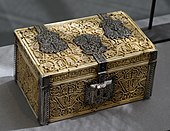
Box with a Kufic inscription on the lid offering wishes and the date; 966; carved ivory and engraved silver; Louvre

Brazier; second half of the 13th century; brass, cast, chased, inlaid with silver and black compound; height: 35.2 cm, width: 39.4 cm; Metropolitan Museum of Art (New York City)

Mosque lamp; shortly after 1285; enameled and gilded glass; height: 26.4 cm; Metropolitan Museum of Art

Mihrab (prayer niche); 1354–1355; mosaic of polychrome-glazed cut tiles on stonepaste body, set into mortar; 343.1 × 288.7 cm, weight: 2041.2 kg; from Isfahan (Iran); Metropolitan Museum of Art

Persian miniature of the Mi'raj of the Prophet by Sultan Mohammed, showing Chinese-influenced clouds and angels; 1539–1543; gouache and ink on paper; height: 28.7 cm; British Library (London)

İznik dish; 16th century; stonepaste, polychrome-painted under transparent glaze; height: 6 cm, diameter: 27.9 cm; Metropolitan Museum of Art

Carpet; 17th century; cotton (warp and weft) and wool (pile), asymmetrically knotted pile; length: 247.65 cm, width: 142.87 cm; Metropolitan Museum of Art
Americas[]

The history of art in the Americas begins in pre-Columbian times with Indigenous cultures. Art historians have focused particularly closely on Mesoamerica during this early era, because a series of stratified cultures arose there that erected grand architecture and produced objects of fine workmanship that are comparable to the arts of Western Europe.
Preclassic[]
The art-making tradition of Mesoamerican people begins with the Olmec around 1400 BC, during the Preclassic era. These people are best known for making colossal heads but also carved jade, erected monumental architecture, made small-scale sculpture, and designed mosaic floors. Two of the most well-studied sites artistically are San Lorenzo Tenochtitlán and La Venta. After the Olmec culture declined, the Maya civilization became prominent in the region. Sometimes a transitional Epi-Olmec period is described, which is a hybrid of Olmec and Maya. A particularly well-studied Epi-Olmec site is La Mojarra, which includes hieroglyphic carvings that have been partially deciphered.
Classic[]

By the late pre-Classic era, beginning around 400 BC, the Olmec culture had declined but both Central Mexican and Maya peoples were thriving. Throughout much of the Classic period in Central Mexico, the city of Teotihuacan was thriving, as were Xochicalco and El Tajin. These sites boasted grand sculpture and architecture. Other Central Mexican peoples included the Mixtecs, the Zapotecs, and people in the Valley of Oaxaca. Maya art was at its height during the "Classic" period—a name that mirrors that of Classical European antiquity—and which began around 200 CE. Major Maya sites from this era include Copan, where numerous stelae were carved, and Quirigua where the largest stelae of Mesoamerica are located along with zoomorphic altars. A complex writing system was developed, and Maya illuminated manuscripts were produced in large numbers on paper made from tree bark. Many sites "collapsed" around 1000 CE.
Postclassic[]
At the time of the Spanish conquest of Yucatán during the 16th and 17th centuries, the Maya were still powerful, but many communities were paying tribute to Aztec society. The latter culture was thriving, and it included arts such as sculpture, painting, and feather mosaics. Perhaps the most well-known work of Aztec art is the calendar stone, which became a national symbol of the state of Mexico. During the Spanish conquest of the Aztec Empire, many of these artistic objects were sent to Europe, where they were placed in cabinets of curiosities, and later redistributed to Western art museums. The Aztec empire was based in the city of Tenochtitlan which was largely destroyed during the colonial era. What remains of it was buried beneath Mexico City. A few buildings, such as the foundation of the Templo Mayor have since been unearthed by archaeologists, but they are in poor condition.
Art in the Americas[]
Art in the Americas since the conquest is characterized by a mixture of indigenous and foreign traditions, including those of European, African, and Asian settlers. Numerous indigenous traditions thrived after the conquest. For example, the Plains Indians created quillwork, beadwork, winter counts, ledger art, and tipis in the pre-reservation era, and afterwards became assimilated into the world of Modern and Contemporary art through institutions such as the Santa Fe Indian School which encouraged students to develop a unique Native American style. Many paintings from that school, now called the Studio Style, were exhibited at the Philbrook Museum of Art during its Indian annual held from 1946 to 1979.
Aztec[]
Arising from the humblest beginnings as a nomadic group of "uncivilizated" wanderers, the Aztecs created the largest empire in Mesoamerican history, lasting from 1427/1428 to 1521. Tribute from conquered states provided the economic and artistic resources to transform their capital Tenochtitlan (Old Mexico City) into one of the wonders of the world. Artists from throughout mesoamerica created stunning artworks for their new masters, fashioning delicate golden objects of personal adornment and formidable sculptures of fierce gods.
The Aztecs entered the Valley of Mexico (the area of modern Mexico City) in 1325 and within a century had taken control of this lush region brimming with powerful city-states. Their power was based on unbending faith in the vision of their patron deity Huitzilopochtli, a god of war, and in their own unparalleled military prowess.
The grandiosity of the Aztec state was reflected in the comportment of the nobility and warriors who had distinguished themselves in battle. Their finely woven and richly embellished clothing was accentuated by iridescent tropical bird feathers and ornate jewellery made of gold, silver, semi-precious stones and rare shells.
Aztec art may be direct and dramatic or subtle and delicate, depending on the function of the work. The finest pieces, from monumental sculptures to masks and gold jewellery, display outstanding craftsmanship and aesthetic refinement. This same sophistication characterizes Aztec poetry, which was renowned for its lyrical beauty and spiritual depth. Aztec feasts were not complete without a competitive exchange of verbal artistry among the finely dressed noble guests.
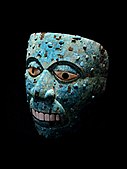
The Mask of Xiuhtecuhtli; 1400–1521; cedrela wood, turquoise, pine resin, mother-of-pearl, conch shell, cinnabar; height: 16.8 cm, width: 15.2 cm; British Museum (London)
The Mask of Tezcatlipoca; 1400–1521; turquoise, pyrite, pine, lignite, human bone, deer skin, conch shell and agave; height: 19 cm, width: 13.9 cm, length: 12.2 cm; British Museum

Double-headed serpent; 1450–1521; Spanish cedar wood (Cedrela odorata), turquoise, shell, traces of gilding & 2 resins are used as adhesive (pine resin and Bursera resin); height: 20.3 cm, width: 43.3 cm, depth: 5.9 cm; British Museum
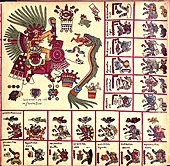
Page 12 of the Codex Borbonicus, (in the big square): Tezcatlipoca (night and fate) and Quetzalcoatl (feathered serpent); before 1500; bast fiber paper; height: 38 cm, length of the full manuscript: 142 cm; (Paris)
Aztec calendar stone; 1502–1521; basalt; diameter: 358 cm; thick: 98 cm; discovered on 17 December 1790 during repairs on the Mexico City Cathedral; National Museum of Anthropology (Mexico City)

Tlāloc effigy vessel; 1440–1469; painted earthenware; height: 35 cm; Museo del Templo Mayor (Mexico City)
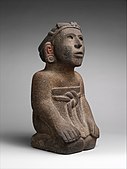
Kneeling female figure; 15th–early 16th century; painted stone; overall: 54.61 × 26.67 cm; Metropolitan Museum of Art (New York City)

Frog-shaped necklace ornaments; 15th–early 16th century; gold; height: 2.1 cm; Metropolitan Museum of Art
Mayan[]
Ancient Maya art refers to the material arts of the Maya civilization, an eastern and south-eastern Mesoamerican culture that took shape in the course of the later Preclassic Period (500 BC to 200 AD). Its greatest artistic flowering occurred during the seven centuries of the Classic Period (c. 200 to 900 CE). Ancient Maya art then went through an extended Post-Classic phase before the upheavals of the sixteenth century destroyed courtly culture and put an end to the Mayan artistic tradition. Many regional styles existed, not always coinciding with the changing boundaries of Maya polities. Olmecs, Teotihuacan and Toltecs have all influenced Maya art. Traditional art forms have mainly survived in weaving and the design of peasant houses.
The jade artworks count among the most wonderful works of art the Maya have left us. The majority of items found date back to the Classic period, but more and more artifacts dating back to the Preclassic are being discovered. The earliest of these include simple, unadorned beads found in burials in Cuello (Belize) dating back to between 1200 and 900 BC. At the time, stone cutting was already highly developed among the Olmecs, who were already working jade before the Maya. In Mesoamerica, jade is found solely as jadeite; nephrite, the other variety known as jade, does not exist there. However, in this area of Mesoamerica "jade" is a collective term for a number of other green or blue stones. Jade objects were placed in burials, used in rituals and, of course, as jewelry. As well as being used for beads, which were often strung together to make highly ornate pendants and necklaces, they were also used for ear spools, arm, calf and foot bands, belts, pectorals (chest jewelry), and to adorn garments and headdresses.
Ancient Maya art is renowned for its aesthetic beauty and narrative content. Of all the media in which Maya artists worked, their paintings on pottery are among the most impressive because of their technical and aesthetical sophistication. These complex pictoral scenes accompanied by hieroglyphic texts recount historic events of the Classic period and reveal the religious ideology upon which the Maya built a great civilization.

Seated king-shaped censer; 4th century; ceramic; height: 80 cm, width: 31.1 cm; Metropolitan Museum of Art (New York City)
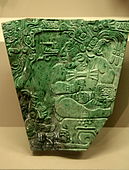
Jade plaque of a Maya king; 400-800 (Classic period); height: 14 cm, width: 14 cm; found at Teotihuacan; British Museum (London)
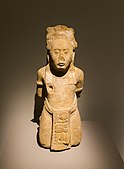
Statue depicting a bound prisoner; 600-900 AD; limestone; from Toniná (Mexico); Musée du quai Branly – Jacques Chirac (Paris)
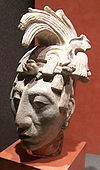
Portrait of K'inich Janaab Pakal I; 615–683; stucco; height: 43 cm; National Museum of Anthropology (Mexico City)

Codex-style vase with a mythological scene; 7th–8th century; ceramic; height: 19 cm, diameter: 11.2 cm; Metropolitan Museum of Art

Vessel with a throne scene; late 7th–8th century; ceramic; 21.59 cm; Metropolitan Museum of Art
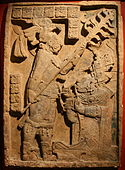
One of the Yaxchilan lintels, this one showing a bloodletting ritual performed by the king of Yaxchilan, and his wife, Lady K'ab'al Xook; 723–726; limestone; height: 108 cm, width: 78 cm; British Museum

Relief showing Aj Chak Maax presenting captives before ruler Itzamnaaj B'alam III of Yaxchilan; 22 August 783; limestone with traces of pigment; height: 1.15 m; Kimbell Art Museum (Fort Worth, Texas, US)
Costa Rica and Panama[]
Long considered a backwater of culture and aesthetic expression, Central America's dynamic societies are now recognized as robust and innovative contributors to the arts of ancient Americas. The people of pre-Columbian Nicaragua, Costa Rica and Panama developed their own distinctive styles in spite of the region being a crossroads for millennia. Its peoples were not subsumed by outside influences but instead created, adopted and adapted all manner of ideas and technologies to suit their needs and temperaments. The region's idiosyncratic cultural traditions, religious beliefs and sociopolitical systems are reflected in unique artworks. A fundamental spiritual tenet was shamanism, the central principle of which decreed that in a trance state, transformed into one's spirit companion form, a person could enter the supranatural realm and garner special power to affect worldly affairs. Central American artists devised ingenious ways to portray this transformation by merging into one figure human and animal characteristics; the jaguar, serpent and avian raport (falcon, eagle or vulture) were the main spirit forms.

Bird pendant; 1st–5th century; jadeite; height: 6.7 cm, width: 1.9 cm, depth: 4.7 cm; from Costa Rica; Metropolitan Museum of Art (New York City)

Pectoral; 5th-10th century; gold alloy; overall: 25.1 × 26.7 cm; from Sitio Conte (Panama); Cleveland Museum of Art (Ohio, US)

Vessel shaped like a turtle's carapace; 11th-14th century; painted ceramic; overall: 22.9 × 29.2 cm; from Panama; Cleveland Museum of Art

Pendant with 2 bat-head warriors who carry spears; 11th–16th century; gold; overall: 7.62 cm (3 in.); from the Chiriqui Province (Panama); Metropolitan Museum of Art
Colombia[]
Gold — the perpetually brilliant metal of status, wealth and power — inspired the Spanish to explore the globe and was an essential accoutrement of prestige, authority and religious ideology among the people of Central America and Colombia.
In Colombia, gold was important for its relationship to the divine force of the sun. It was part of a complex ideology of universal binary oppositions: male-female, light-dark, the earth and spirit worlds. Gold body adornments were cast in complex forms, their iconography communicating social, political and spiritual potency through portrayals of powerful shaman-rulers, lineage totems and supranatural protector spirits.

Yotoco animal-headed figure pendant; 1st–7th century; gold; height: 6.35 cm; Metropolitan Museum of Art (New York City)
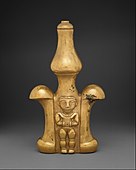
Quimbaya lime container; 5th–9th century; gold; height: 23 c; Metropolitan Museum of Art
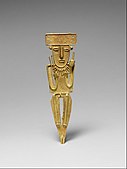
Muisca male figure (tunjo); 10th–mid-16th century; gold; height: 14.9 cm; Metropolitan Museum of Art
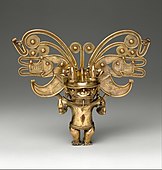
Tairona pendant; 10th–16th century; gold; height: 14 cm; Metropolitan Museum of Art
Andean regions[]
The ancient civilizations of Peru and Bolivia nurtured unique artistic traditions, including one of the world's most aesthetically impressive fibre art traditions, seen on artifacts from clothing to burial shrouds to architectural embellishment. The origins of Andean civilization reach back before 3000 BC. Harnessing the challenging environments – which included the world's driest coastal desert, desolate windswept highlands and formidable mountains – Andean pre-Columbian people excelled in agriculture, marine fishing and animal husbandry. By 1800 BC ritual and civic buildings elevated on massive adobe platforms dominated the larger settlements, particularly in the coastal river valleys. Two of the first important cultures from this land are the Chavín and the Paracas culture.
The Moche controlled the river valleys of the north coast, while the Nazca of southern Peru held sway along the coastal deserts and contiguous mountains, inheriting the technological advances – in agriculture and architecture – as well as the artistic traditions of the earlier Paracas people. Both cultures flourished around 100–800 AD. Moche pottery is some of the most varied in the world. The use of mold technology is evident. This would have enabled the mass production of certain forms. Following the decline of the Moche, two large co-existing empires emerged in the Andes region. In the north, the Wari (or Huari) Empire. The Wari are noted for their stone architecture and sculpture accomplishments, but their greatest proficiency was ceramic. The Wari produced magnificent large ceramics, many of which depicted images of the Staff God.
The Chimú were preceded by a simple ceramic style known as Sicán (700–900 AD) which became increasingly decorative until it became recognizable as Chimú in the early second millennium. The Chimú produced excellent portrait and decorative works in metal, notably gold but especially silver. The Chimú also are noted for their featherwork, having produced many standards and headdresses made of a variety of tropical feathers which were fashioned into bired and fish designs, both of which were held in high esteem by the Chimú.
The Raimondi Stela; by Chavín culture; 5th-3rd century BC; granite; height: 1.95 m; Museo Nacional de Arqueología, Antropología e Historia del Perú (Lima, Peru)
Aerial photograph of one of the Nazca lines, taken in July 2015. In this photo appears the line named "The monkey"

Ceremonial mantle with representations of supernatural beings; by Paracas culture; 100 BC-100 AD; embroidered plain cotton weave; height: 12.8 cm, width: 12.9 cm; Lima Art Museum (Lima, Peru)
Moche portrait vessel of a ruler; by Moche culture; 100 BC-500 AD; ceramic & pigment; Art Institute of Chicago (US)

Anthropomorphic figure; from the Wari empire; 7th-10th century; burned clay; from Mantaro Valley; Museum Rietberg (Zürich, Switzerland)

Funerary mask; by Sican culture; 900–1100; gold, silver and cinnabar; height: 29.2, width: 49.5 cm; Metropolitan Museum of Art (New York City)

Ceremonial knife (tumi); by Sican culture; 10th–13th century; gold, turquoise, greenstone & shell; height: 33 cm (1 ft. 1 in.); Metropolitan Museum of Art
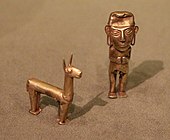
Figurines of a man and a llama; from the Inca empire; 1400–1532; gold; Cleveland Museum of Art (Ohio, US)
Amazonia and the Caraibbes[]
The tropical climate of the Caraibbean islands and the Amazonian rainforest is not favorable to the preservation of artefacts made from wood and other materials. What survived reveals complex societies whose people created art rich in mythological and spiritual meaning.
The Taino people, who occupied the Caraibbean islands when the Spanish arrived, were agriculturalists whose society was centred on hereditary chiefs called caciques. Their towns included impressively constructed ceremonial plazas in which ball games were played and religious rituals carried on, linking their culture to that of the Maya from the Yucatán Peninsula. Much of Taino art was associated with shamanic rituals and religion, including a ritual in which a shaman or a cacique enters into a hypnotic state by inhaling the hallucinogetic cohoba powder. Sculptures representing the creator god Yocahu often depict a nude male figure in a squatting position with a slightly concave dish on top of his head, to hold the cohoba powder. Other figures (always male) stand rigidly frontal, the ostentatious display of their genitals apparently to the importance of fertility. The purpose of these rituals was communication with the ancestors and the spirit world. Chiefs and shamans (often the same person) sometimes interceded with spirit beings from a sculpted stool, or duho.
Meanwhile, the Marajoara culture flourished on Marajó island at the mouth of the Amazon River, in Brazil. Archeologists have found sophisticated pottery in their excavations on the island. These pieces are large, and elaborately painted and incised with representations of plants and animals. These provided the first evidence that a complex society had existed on Marajó. Evidence of mound building further suggests that well-populated, complex and sophisticated settlements developed on this island, as only such settlements were believed capable of such extended projects as major earthworks.[25] The pottery that they made is decorated with abstract lines and spirals, suggesting that they probably consumed hallucinogenic plants. The Marajoara culture produced many kinds of vessels including urns, jars, bottles, cups, bowls, plates and dishes.

Spatula; 10th-15th century; manatee bone; overall: 19.1 × 3.2 × 11 cm; Cleveland Museum of Art (Ohio, US)

Taino deity figure (Zemi); 15th–16th century CE; wood & shell; probably from the Dominican Republic; Metropolitan Museum of Art (New York City)
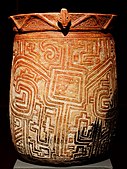
Marajoara cylindrical vessel; 400–1000 CE; ceramic with creamy white slip under reddish brown paint; height: 38.5 cm; from the Marajó island (Brazil)

Large funerary vessel; 400–1400; ceramic with creamy white slip under reddish brown paint; height: 89 cm; from the Marajó island
United States and Canada[]
The most famous native American art style from the United States and Canada is the one of the Northwest Coast, famous for its totems and color combinations.
The art of the Haida, Tlingit, Heiltsuk, Tsimshian and other smaller tribes living in the coastal areas of Washington state, Oregon, and British Columbia, is characterized by an extremely complex stylistic vocabulary expressed mainly in the medium of woodcarving. Famous examples include totem poles, transformation masks, and canoes. In addition to woodwork, two dimensional painting and silver, gold and copper engraved jewelry became important after contact with Europeans.
The Eastern Woodlands, or simply woodlands, cultures inhabited the regions of North America east of the Mississippi River at least since 2500 BC. While there were many regionally distinct cultures, trade between them was common and they shared the practice of burying their dead in earthen mounds, which has preserved a large amount of their art. Because of this trait the cultures are collectively known as the Mound builders.
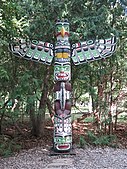
Kwakwaka'wakw totem in Ottawa (Canada)

Mogollon bowl with a geometric design and a pronghorn antelope; 1000–1150; earthenware; diameter: 31.2 cm, overall: 12.5 × 32 cm; Cleveland Museum of Art (Ohio, US)
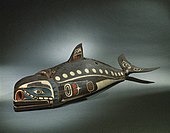
Kwakwaka'wakw whale figure; 19th century; cedar wood, hide, cotton cord, nails & pigment; 60 × 72.4 × 206 cm; Brooklyn Museum (New York City)

Thunderbird transformation mask; 19th century; cedar, pigment, leather, nails and metal plate; 121.9 × 180.3 × 38.1 cm; Brooklyn Museum
Inuit[]
Inuit art refers to artwork produced by Inuit people, that is, the people of the Arctic previously known as Eskimos, a term that is now often considered offensive outside Alaska. Historically, their preferred medium was walrus ivory, but since the establishment of southern markets for Inuit art in 1945, prints and figurative works carved in relatively soft stone such as soapstone, serpentinite, or argillite have also become popular. The range of colors is cold, most encountered being: black, brown, grays, white and gray-blue.
The Winnipeg Art Gallery has a large public collection of contemporary Inuit art.[26] In 2007, the Museum of Inuit Art opened in Toronto,[27] but closed due to lack of resources in 2016.[28] Carvings Nunavut, owned by Inuk Lori Idlout, opened in 2008 and has grown to have the largest private collection in Nunavut. The Inuit owned and operated gallery includes a wide selection of Inuit made art that has millions in inventory.[29]

Old Bering Sea head; 2nd–4th century; ivory (walrus); height: 6.35 cm (21⁄2 in.); Metropolitan Museum of Art (New York City)

Punuk knife handle; 11th–12th century; walrus ivory; height: 3.8 cm, width: 14 cm; Metropolitan Museum of Art
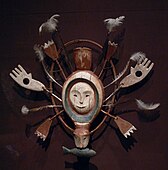
Yupik mask with seal or sea otter spirit; late 19th century; wood, paint, gut cord, & feathers; Dallas Museum of Art (Texas, US)
Yupik boat mask of a shaman; 1883; Ethnological Museum of Berlin (Germany)
Asian[]
Eastern civilization broadly includes Asia, and it also includes a complex tradition of art making. One approach to Eastern art history divides the field by nation, with foci on Indian art, Chinese art, and Japanese art. Due to the size of the continent, the distinction between Eastern Asia and Southern Asia in the context of arts can be clearly seen. In most of Asia, pottery was a prevalent form of art. The pottery is often decorated with geometric patterns or abstract representations of animals, people or plants. Other very widespread forms of art were, and are, sculpture and painting.
Central Asia[]
The art of ancient and medieval Central Asia reflects the rich history of this vast area, home to a huge variety of peoples, religions and ways of life. The artistic remains of the region show a remarkable combinations of influences that exemplify the multicultural nature of Central Asian society.
From the late second millennium BC until very recently, the grasslands of Central Asia – stretching from the Caspian Sea to central China and from southern Russia to northern India – have been home to migrating herders who practised mixed economies on the margins of sedentary societies. The prehistoric 'animal style' art of these pastoral nomads not only demonstrates their zoomorphic mythologies and shamanic traditions but also their fluidity in incorporating the symbols of sedentary society into their own artworks.
Central Asia has always been a crossroads of cultural exchange, the hub of the so-called Silk Road – that complex system of trade routes stretching from China to the Mediterranean. Already in the Bronze Age (3rd and 2nd millennium BC), growing settlements formed part of an extensive network of trade linking Central Asia to the Indus Valley, Mesopotamia and Egypt.[30]

Scarface; 2200-1700 BC; chlorite, calcite, meteoric iron and shell; height: 12 cm; Louvre[31]

Final (kulan); 6th-5th century BC; bronze; 14.5 × 9 cm; Los Angeles County Museum of Art (US)

Belt buckle; 3rd-1st centuries BC; gold; length: 7.9 cm; Metropolitan Museum of Art
Deva; Hadda, Afghanistan, 4th to 5th centuries AD; stucco; height: 55 cm; Guimet Museum (Paris)[32]</ref>
Goddess and celestial musician, Kizil Caves, 5th century; pigments on plaster; height: 2.03 m; Museum of Asian Art (Berlin, Germany)[31]
Warrior statue; 8th-10th century; from the Kosh-Agach region (Altai); Hermitage (Sankt Petersburg, Russia)

Suzani (ceremonial hanging); late 1700s; cotton; 92 × 63; from Uzbekistan; Indianapolis Museum of Art (US)
Indian[]
Early Buddhists in India developed symbols related to Buddha. The major survivals of Buddhist art begin in the period after the Mauryans, within North India Kushan art, the Greco-Buddhist art of Gandhara and finally the "classic" period of Gupta art. Additionally, there was the Andhra school which appeared before the Gandhara school and which was based in South India.[33] Good quantities of sculpture survives from some key sites such as Sanchi, Bharhut and Amaravati, some of which remain in situ, with others in museums in India or around the world. Stupas were surrounded by ceremonial fences with four profusely carved toranas or ornamental gateways facing the cardinal directions. These are in stone, though clearly adopting forms developed in wood. They and the walls of the stupa itself can be heavily decorated with reliefs, mostly illustrating the lives of the Buddha. Gradually life-size figures were sculpted, initially in deep relief, but then free-standing.[34] Mathura art was the most important centre in this development, which applied to Hindu and Jain art as well as Buddhist.[35] The facades and interiors of rock-cut chaitya prayer halls and monastic viharas have survived better than similar free-standing structures elsewhere, which were for long mostly in wood. The caves at Ajanta, Karle, Bhaja and elsewhere contain early sculpture, often outnumbered by later works such as iconic figures of the Buddha and bodhisattvas, which are not found before 100 AD at the least.

The Lion Capital of Ashoka; c. 250 BC; sandstone; height: 2.15 m; Sarnath Museum (India)

Seated Buddha; c. 475; sandstone; height: 1.6 m; Sarnath Museum
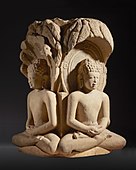
Chaumukha idol; c. 600; sandstone; 58.42 × 43.18 × 44.45 cm; Los Angeles County Museum of Art (US)

Bodhisattva Padmapani; 450–490; pigments on rock; height: c. 1.2 m; Ajanta Caves (India)

The Kandariya Mahadeva Temple (Khajuraho, Madhya Pradesh, India), c. 1030

Nataraja; c. 11th century; copper alloy; height: 68.3 cm, diameter: 56.5 cm; Metropolitan Museum of Art (New York City)

The Taj Mahal (Agra, India), the most well-known example of Mughal architecture, c. 1649
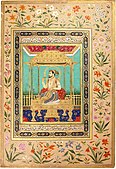
Portrait of Shah Jahan on the Peacock Throne; 19th century; height of the page: 37.2 cm, height of the painting: 16.5 cm; Metropolitan Museum of Art
Nepalese, Bhutanese, and Tibetan[]
For more than a thousand years, Tibetan artists have played a key role in the cultural life of Tibet. From designs for painted furniture to elaborate murals in religious buildings, their efforts have permeated virtually every facet of life on the Tibetan plateau. The vast majority of surviving artworks created before the mid-20th century are dedicated to the depiction of religious subjects, with the main forms being thangka, distemper paintings on cloth, Tibetan Buddhist wall paintings, and small statues in bronze, or large ones in clay, stucco or wood. They were commissioned by religious establishments or by pious individuals for use within the practice of Tibetan Buddhism and were manufactured in large workshops by monks and lay artists, who are mostly unknown.
The art of Tibet may be studied in terms of influences which have contributed to it over the centuries, from other Chinese, Nepalese, Indian, and sacred styles. Many bronzes in Tibet that suggest Pala influence, are thought to have been either crafted by Indian sculptors or brought from India.[36]
Bhutanese art is similar to the art of Tibet. Both are based upon Vajrayana Buddhism, with its pantheon of divine beings. The major orders of Buddhism in Bhutan are Drukpa Kagyu and Nyingma. The former is a branch of the Kagyu School and is known for paintings documenting the lineage of Buddhist masters and the 70 Je Khenpo (leaders of the Bhutanese monastic establishment). The Nyingma order is known for images of Padmasambhava, who is credited with introducing Buddhism into Bhutan in the 7th century. According to legend, Padmasambhava hid sacred treasures for future Buddhist masters, especially Pema Lingpa, to find. The treasure finders (tertön) are also frequent subjects of Nyingma art.

Figurine; 14th–15th century; gilt-copper alloy; height: 13.5 cm, width: 9.8 cm; Metropolitan Museum of Art (New York City)
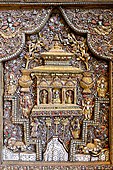
Altar; 1700–1899; metal, stones and filigree; length: 130.7 cm; British Museum (London)

Gorget; 18th century; silver and various gemstones; overall: 8.9 cm, the chain: 13.7 cm; from Tibet; Cleveland Museum of Art (Cleveland, US)

Painted medicine Buddha mandala with goddess Prajnaparamita in center; 19th century; Rubin Museum of Art (New York City)
Chinese[]
In Eastern Asia, painting was derived from the practice of calligraphy, and portraits and landscapes were painted on silk cloth. Most of the paintings represent landscapes or portraits. The most spectacular sculptures are the ritual bronzes and the bronze sculptures from Sanxingdui. A very well-known example of Chinese art is the Terracotta Army, depicting the armies of Qin Shi Huang, the first Emperor of China. It is a form of funerary art buried with the emperor in 210–209 BC whose purpose was to protect the emperor in his afterlife.
Chinese art is one of the oldest continuous traditional arts in the world, and is marked by an unusual degree of continuity within, and consciousness of, that tradition, lacking an equivalent to the Western collapse and gradual recovery of classical styles. The media that have usually been classified in the West since the Renaissance as the decorative arts are extremely important in Chinese art, and much of the finest work was produced in large workshops or factories by essentially unknown artists, especially in Chinese ceramics. The range and quality of goods that decorated Chinese palaces and households, and their inhabitants, is dazzling. Materials came from across China and far beyond: gold and silver, mother of pearl, ivory and rhinoceros horn, wood and lacquer, jade and soap stone, silk and paper.

Votive stele with Buddha Shakyamuni; dated 542 (Eastern Wei Dynasty); limestone; Museum Rietberg (Zürich, Switzerland)
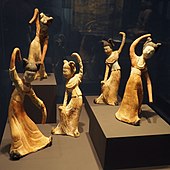
Statuettes of dancers; 8th century (Tang Empire); ceramic; Historical Museum of Bern (Switzerland)

Wang Xizhi watching geese; by Qian Xuan; 1235-before 1307; handscroll (ink, color and gold on paper); Metropolitan Museum of Art (New York City)

Covered box with pavilion and figures; 1300s (the Yuan dynasty); carved lacquer; Tokyo National Museum (Tokyo)

The David Vases; 1351 (the Yuan dynasty); porcelain, cobalt blue decor under glaze; height: 63.8 cm; British Museum (London)

Pilgrim flask decorated with peaches and pomegrenates, made with the cloisonné technique; 1st half of the 17th century (the Ming Dynasty); Museum Rietberg

Hall of Prayer for Good Harvests, the main building of the Temple of Heaven (Beijing), 1703-1790
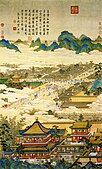
Peaceful Start for the New Year; by Ding Guanpeng; 1748; ink and color on paper; height: 179.3 cm; National Palace Museum (Taipei, Taiwan)
Japanese[]

Japanese art covers a wide range of art styles and media, including ancient pottery, sculpture, ink painting and calligraphy on silk and paper, ukiyo-e paintings and woodblock prints, ceramics, origami, and more recently manga—modern Japanese cartooning and comics—along with a myriad of other types.
The first settlers of Japan, the Jōmon people (c. 11,000–300 BC). They crafted lavishly decorated pottery storage vessels, clay figurines called dogū. Japan has been subject to sudden invasions of new ideas followed by long periods of minimal contact with the outside world. Over time the Japanese developed the ability to absorb, imitate, and finally assimilate those elements of foreign culture that complemented their aesthetic preferences. The earliest complex art in Japan was produced in the 7th and 8th centuries in connection with Buddhism. In the 9th century, as the Japanese began to turn away from China and develop indigenous forms of expression, the secular arts became increasingly important; until the late 15th century, both religious and secular arts flourished. After the Ōnin War (1467–1477), Japan entered a period of political, social, and economic disruption that lasted for over a century. In the state that emerged under the leadership of the Tokugawa shogunate, organized religion played a much less important role in people's lives, and the arts that survived were primarily secular.
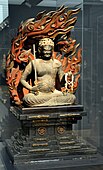
Fudo Myoo (Acala), king of mystical knowledge; late 12th century (Fujiwara period); cypress wood with remains of colored frame; Museum Rietberg (Zürich, Switzerland)
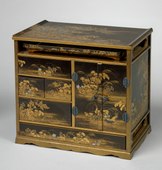
Incense guessing game; 1615–1868; lacquer; overall: 23 × 25.4 × 16.6 cm; Cleveland Museum of Art (Cleveland, Ohio, US)
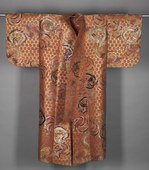
Robe; early 1700s; silk and brocaded metal thread; overall: 139.7 × 133.3 cm; Cleveland Museum of Art
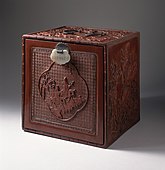
Japanese chest with a cartouche showing figures on donkeys in a landscape; 1750–1800; carved red lacquer on wood core with metal fittings and jade lock; 30.64 × 30.16 × 12.7 cm; Los Angeles County Museum of Art (USA)

Three Beauties of the Present Day; by Kitagawa Utamaro; c. 1793; height: 3.87 cm (15.23 in), width: 2.62 cm (10.31 in); Toledo Museum of Art (Toledo, Ohio, US)
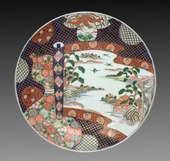
Plate; 1800s; overglaze enameled porcelain; diameter: 48.3 cm, overall: 5.7 cm; Cleveland Museum of Art
Inrō; 19th century; wood, lacquer and gold; Historical Museum of Bern (Switzerland)
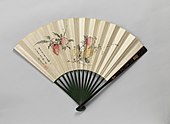
Painted folding fan; by Yamamoto Baiitsu; 1832; ink and color on paper; Image:17 × 47.5 cm; Metropolitan Museum of Art (New York City)
Korean[]
Korean arts include traditions in calligraphy, music, painting and pottery, often marked by the use of natural forms, surface decoration and bold colors or sounds.
The earliest examples of Korean art consist of Stone Age works dating from 3000 BC. These mainly consist of votive sculptures and more recently, petroglyphs, which were rediscovered. This early period was followed by the art styles of various Korean kingdoms and dynasties. Korean artists sometimes modified Chinese traditions with a native preference for simple elegance, spontaneity, and an appreciation for purity of nature.
The Goryeo Dynasty (918–1392) was one of the most prolific periods for a wide range of disciplines, especially pottery. The Korean art market is concentrated in the Insadong district of Seoul where over 50 small galleries exhibit and occasional fine arts auctions. Galleries are cooperatively run, small and often with curated and finely designed exhibits. In every town there are smaller regional galleries, with local artists showing in traditional and contemporary media. Art galleries usually have a mix of media. Attempts at bringing Western conceptual art into the foreground have usually had their best success outside of Korea in New York, San Francisco, London and Paris.

Statue of Maitreya in meditation; 6th-7th century; gilt bronze; height: 83.2 cm; National Museum of Korea (Seoul)

Water-moon Kwanseumǔm; early 14th century; hanging scroll, ink and colours on silk; 1.14 × 0.55 m; Metropolitan Museum of Art (New York City)

Family of Tigers; 17th century; ink and colour on paper; height: 584.20 mm, width: 371.47 mm; Denver Art Museum (Denver, Colorado, US)

Buddha Seokgamoni (Shakyamuni) preaching to the assembly on vulture peak; 1755; unmounted, ink and color on silk; approximatively 335.28 × 406.4 cm; Los Angeles County Museum of Art
South-east Asian[]

The arts of South-east Asia, a region stretching from Burma (aka Myanmar) and the Indonesian island of Sumatra in the west to Papua New Guinea and the Philippines in the east, is extraordinarily rich and varied, owing much to the cultural influences from India that came with the introduction of Hinduism and Buddhism in the early centuries AD. Here live populations of widely diverse ethnic origins, speaking hundreds of different languages and existing at different stages of cultural evolution. With only a few exceptions, these peoples have been subjected in the course of their long histories to outside cultural influences of varying intensity from the Islamic world, China and the West, as well as from India. Much of South-east Asian art is religious in nature. The penetration of Hindu and Buddhist influences from India has been especially profound in the mainland countries of Burma, Thailand, Cambodia and Laos. Christian influences are prevalent in the Philippines and Timor-Leste. Chinese influences has been more limited, except Vietnam, which was under Chinese hegemony from the 2nd century BC to the 10th century AD.
Early South-east Asian rulers built state temples to establish their legitimacy and give material expression to their power and authority. These were often decorated with relief sculptures of great vitality and originality, which nevertheless always conformed to established iconographic conventions for the depiction of Hindu and Buddhist themes.
South-east Asian artists have long excelled at fresco painting and painting on lacquer, particularly in the Buddhist countries of the mainland and in Hindu Bali. Frescos and generally painted on the inner walls of the galleries surrounding temple enclosures, while painted lacquer is mainly applied to wooden objects: panels, cabinets, chests, doors and shutters. The subject matter of both forms of painting in generally confined to depictions of Hindu deities; stories from the Hindu epics, the Ramayana and the Mahabharata; episodes from the life of the historical Buddha and tales of his previous lives (jatakas); and other Hindu and Buddhist themes.

Seated deity; late 9th; sandstone; from Champa (Quang Nam Province, Temple Complex of Dong-du'o'ng); Rietberg Museum (Zürich, Switzerland)

Tollitama pediment; from Cambodia; 976; pink sandstone; 196 × 269 cm; Musée Guimet (Paris)
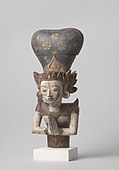
Statue of a goddess; 1775–1825; wood, glass, paint and gilding; height: 41.2 cm, width: 18.5 cm, depth: 12.0 cm, weight: 1.5 kg; Rijksmuseum (Amsterdam, the Netherlands)

A page of the Phra Malai Manuscript; opaque watercolor and ink on paper; covers: gilded and lacquered paper; c. 1860–1880; 13.97 × 68.26 × 6.35 cm; Los Angeles County Museum of Art (US)
Kain sarong prada (ceremonial skirt cloth); from Indramaya (Java, Indonesia); late 19th century; cotton, gold leaf, plain weave, batik (resist dyed); Honolulu Museum of Art (Hawaii, US)

Agusan image deity; 9th-10th century; gold statue; from the Philippines; Field Museum of Natural History (Chicago)
Madonna with Child statue; 1600's; ivory with silver; from the Philippines; Seville Cathedral (Spain)

Wayang Kulit, also known as Wajang Koelit, is a form of puppet theatre art found in Java, Indonesia and other parts of South-east Asia
Africa[]

African art includes both sculpture, typified by the brass castings of the Benin people, as well as folk art. Concurrent with the European Middle Ages, in the eleventh century AD a nation that made grand architecture, gold sculpture, and intricate jewelry was founded in Great Zimbabwe. Impressive sculpture was concurrently being cast from brass by the Yoruba people of what is now Nigeria. Such a culture grew and was ultimately transformed to become the Benin Kingdom, where elegant altar tusks, brass heads, plaques of brass, and palatial architecture was created. The Benin Kingdom was ended by the British in 1897, and little of the culture's art now remains in Nigeria. Today, the most significant arts venue in Africa is the Johannesburg Biennale.
Sub-Saharan Africa is characterized by a high density of cultures. Notable are the, Dogon people from Mali; Edo, Yoruba, Igbo people and the Nok civilization from Nigeria; Kuba and Luba people from Central Africa; Ashanti people from Ghana; Zulu people from Southern Africa; and Fang people from Equatorial Guinea (85%), Cameroon and Gabon; the Sao civilization people from Chad; Kwele people from eastern Gabon, Republic of the Congo and Cameroon.
The myriad forms of African art are components of some of the most vibrant and responsive artistic traditions in the world and are integral to the lives of African people. Created for specific purposes, artworks can reveal their ongoing importance through physical transformations that enhance both their appearance and their potency. Many traditional African art forms are created as conduits to the spirit world and change appearance as materials are added to enhance their beauty and potency. The more a work is used and blessed, the more abstract it becomes with the accretion of sacrificial matter and the wearing down of original details.

Seated figure; by Nok culture; 5th century BC—5th century AD; terracotta; height: 38 cm; Musée du quai Branly (Paris)
Head of a king or dignitary; by Yoruba people; 12th—15th century AD; terracotta; discovered at Ife (Nigeria); Ethnological Museum of Berlin (Germany)

Seated figure; 13th century; terracotta; height: 29.9 cm; from Djenné-Djenno (Mali); Metropolitan Museum of Art (New York City)

Benin ivory mask which depicts Idia; from the Kingdom of Benin; early 16th century; ivory with iron inlay; height: 23.8 cm, weight: 12.7 cm, depth: 8.3 cm; Metropolitan Museum of Art

Plaque with warriors and attendants; from the Kingdom of Benin; 16th—17th century; brass; height: 47.6 cm; Metropolitan Museum of Art
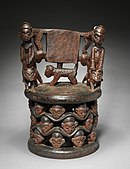
Prestige chair; by ; c. 1800; wood; overall: 80.7 × 53.3 × 44.5 cm; Cleveland Museum of Art (Ohio, US)
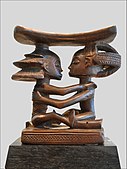
Headrest; by Luba people; 19th century; wood; height: 18.5 cm (7.2 in), width: 19 cm (7.4 in), thickness: 8 cm (3.1 in); Musée du quai Branly

Mask; by Fang people; c. 1895; wood coloured with kaolin; height: 78 cm; Ethnological Museum of Berlin (Germany)

Mask; by Kwele people; early 20th century; painted wood; height: 63 cm; Muséum d'Histoire naturelle de La Rochelle (La Rochelle, France)

Mask; by Yaka people; early 20th century; wood, raffia & color pigments; Museum Rietberg (Zürich, Switzerland)
Buffalo mask; possibly by Bwa people; early-mid 1900s; fibres and painted wood; Cleveland Museum of Art

A traditional tata-somba house in Benin
Oceania[]
The Art of Oceania includes the geographic areas of Micronesia, Polynesia, Australia, New Zealand, and Melanesia. One approach treats the area thematically, with foci on ancestry, warfare, the body, gender, trade, religion, and tourism. Unfortunately, little ancient art survives from Oceania. Scholars believe that this is likely because artists used perishable materials, such as wood and feathers, which did not survive in the tropical climate, and there are no historical records to refer to most of this material. The understanding of Oceania's artistic cultures thus begins with the documentation of it by Westerners, such as Captain James Cook, in the 18th century. At the turn of the 20th century the French artist Paul Gauguin spent significant amounts of time in Tahiti, living with local people and making modern art — a fact that has become intertwined with Tahitian visual culture to the present day.[citation needed] The indigenous art of Australia often looks like abstract modern art, but it has deep roots in local culture.
The art of Oceania is the last great tradition of art to be appreciated by the world at large. Despite being one of the longest continuous traditions of art in the world, dating back at least fifty millennia, it remained relatively unknown until the second half of the 20th century.
The often ephemeral materials of Aboriginal art of Australia makes it difficult to determine the antiquity of the majority of the forms of art practised today. The most durable forms are the multitudes of rock engravings and rock paintings which are found across the continent. In the Arnhem Land escarpment, evidence suggests that paintings were being made fifty thousand years ago, antedating the Palaeolithic rock paintings of Altamira & Lascaux in Europe.

Head; 9th–11th century; vesicular basalt; height: 19.7 cm, width: 15.5 cm; from Hawaii; Metropolitan Museum of Art (New York City)

Moais at Rano Raraku (the Easter Island). The Moais are monolithic human figures carved by the Rapa Nui people on Easter Island between the years 1250 and 1500[37]

Taurapa (māori canoe sternpost); late 18th-early 19th century; wood and sheel; height: 148 cm; Musée du quai Branly (Paris)[38]

Māori part of a treasure chest; c. 1850; from the New Zealand; Musée du quai Branly (Paris)

Uli figure; c. 19th century; painted wood, cowrie snail, cap of the turbo-snail and bast fibers; from New Ireland Province (Papua New Guinea); Rietberg Museum (Zürich, Switzerland)

Battle shield; 19th-early 20th centuries; wood, grass and raffia; from Kambrambo (Lower Sepik Region, Papua New Guinea); Museum Rietberg
Masi (barkcloth); 20th century; from Fiji; Honolulu Museum of Art (Hawaii, US)
Men's club house, 1907, from Palau, now in Ethnological Museum of Berlin (Germany)
Detail of a ceremonial supply house, from Papua New Guinea, now in Ethnological Museum of Berlin
Necklace; before 1909; shark vertebrae, shell (Cassis rufa), glass beads, fibre; diameter: c. 35 cm; from Wuvulu (Papua New Guinea); Museum Five Continents (Munich, Germany)[39]
Necklace; before 1912; sea urchin spines, fibre; diameter: c. 30 cm; Museum Five Continents[39]

Painting of a kangaroo totemic ancestor; 1915; painting on bark; 92.5 × 35.5 × 5.5 cm; Alligator Rivers (Arnhem Land, Australia); Musée du quai Branly (Paris)
European[]
Medieval[]
With the decline of the Roman Empire, the Medieval era began, lasting for a millennium. Early Christian art begins the period, followed by Byzantine art, Anglo-Saxon art, Viking art, Ottonian art, Romanesque art and Gothic art, with Islamic art dominating the eastern Mediterranean.
In Byzantine and Gothic art of the Middle Ages, the dominance of the church resulted in a large amount of religious art. There was extensive use of gold in paintings, which presented figures in simplified forms.
Byzantine[]

Byzantine art refers to the body of Christian Greek artistic products of the Eastern Roman (Byzantine) Empire,[40][41] as well as the nations and states that inherited culturally from the empire. Though the empire itself emerged from Rome's decline and lasted until the Fall of Constantinople in 1453,[42] the start date of the Byzantine period is rather clearer in art history than in political history, if still imprecise. Many Eastern Orthodox states in Eastern Europe, as well as to some degree the Muslim states of the eastern Mediterranean, preserved many aspects of the empire's culture and art for centuries afterward.
Icons (from the Greek εἰκών eikōn "image", "resemblance") are the most important visual elements in Byzantine religious practice, central to Orthodox worship since the end of Iconoclasm in the ninth century. Consistent in their format in order to preserve a sense of portraiture and the familiarity of favoured images, they have nevertheless transformed over time. An unusual characteristic of Byzantine art are the golden backgronds. Clear glass was often backed with gold leaves to create a rich, shimmering effect.
Carried by patriarchs in Eastern processions, read by monks in secluded caves and held by emperors at important ceremonies, sacred books, often beautifully illustrated, were central to Byzantine belief and ritual. Few manuscripts seem to have been produced in the Early Byzantine period between the sixth and eighth centuries CE, but there was a flourishing of painted books in the ninth century, following the end of Iconoclasm.
Jewelry, worn by men, women and children, was a clear indication of rank and wealth in Byzantine society. Styles varied from bold, heavy goldwork with striking large cabochon stones to extraordinarily delicate gold filigree and granulation. Ornament ranged from decorative patterning to floral and animal motifs to complex Christian iconography. Often jewellery was attached to ceremonial dress that did not often require cleaning. A popular technique from the 3rd to 7th centuries was opus interrasile or diatrita, in which fine thin sheets of gold were pierced, creating a lace-like effect that is both beautiful and economical, as it reduces the weight of gold used. By the 5th century, stimulated by trade with the East, colored precious and semi-precious stones, polished rather than cut, were incorporated. Decorative designs were picked out in gold priced work, highlighted in dark niello (a silver sulphide that contrasted to gold and silver) or, from the 9th century, depicted in enamel.[43]

Slab with a relief representing the Nativity of Jesus; 4th-early 5th century; marble; Byzantine and Christian Museum (Athens)

Apse of the Santa Maria Maggiore church in Rome, decorated in the 5th century with this glamorous mosaic
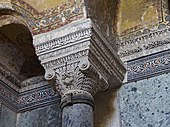
Basket capital from Hagia Sophia (Istanbul, Turkey)
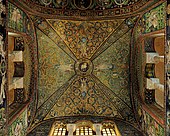
Mosaics on a ceiling and some walls of the Basilica of San Vitale in Ravenna (Italy), c. 547 AD

The Little Metropolis in Athens, built on unknown dates, between the 9th century to the 13th century

Gospel lectionary; c. 1100; tempera, gold, and ink on parchment, and leather binding; overall: 36.8 × 29.6 × 12.4 cm, folio: 35 × 26.2 cm; Metropolitan Museum of Art

Icon of the New Testament Trinity; c. 1450; tempera and gold on wood panel (poplar); Cleveland Museum of Art (Cleveland, Ohio, US)

Page of an Armenian illuminated manuscript; 1637–1638; tempera colors, gold paint, and gold leaf on parchment; height: 25.2 cm; Getty Center (Los Angeles)
Anglo-Saxon[]
Anglo-Saxon art covers art produced within the Anglo-Saxon period of English history, beginning with the Migration period style that the Anglo-Saxons brought with them from the continent in the 5th century, and ending in 1066 with the Norman Conquest of a large Anglo-Saxon nation-state whose sophisticated art was influential in much of northern Europe. The two periods of outstanding achievement were the 7th and 8th centuries, with the metalwork and jewellery from Sutton Hoo and a series of magnificent illuminated manuscripts, and the final period after about 950, when there was a revival of English culture after the end of the Viking invasions. By the time of the Conquest the move to the Romanesque style is nearly complete. The important artistic centres, in so far as these can be established, were concentrated in the extremities of England, in Northumbria, especially in the early period, and Wessex and Kent near the south coast.

Buckle of Sutton Hoo; 580–620; gold and niello; length: 13.1 cm; British Museum (London)

The helmet of Sutton Hoo; early 7th century AD; coppery alloy, iron, gold and garnet; height: 31.8 cm; British Museum
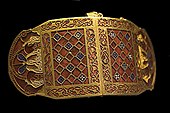
Shoulder-clasps from Sutton Hoo; early 7th century; gold, glass & garnet; length: 12.7 cm; British Museum

The Incipit to Matthew from the Book of Lindisfarne; late 7th century; ink and pigments on vellum; 34 × 25 cm; British Library (London)
Viking art[]
Viking art, also known commonly as Norse art, is a term widely accepted for the art of Scandinavian Norsemen and Viking settlements further afield—particularly in the British Isles and Iceland—during the Viking Age of the 8th–11th centuries CE. Viking art has many design elements in common with Celtic, Germanic, the later Romanesque and Eastern European art, sharing many influences with each of these traditions.[44]
One of the Stora Hammars stones; c. 750; limestone; height: 3.7 m; Lärbro (Sweden)

Plaque decorated with confronted monster heads; 8th-late 9th century; whale bone; 22 × 18.3 × 0.8 cm; Walters Art Museum (Baltimore, US)
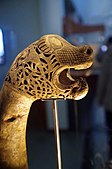
Animal head post; c. 820; wood; height: 51 cm; Viking Ship Museum (Oslo, Norway)
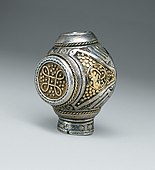
Terminal for an open ring brooch; c. 950; silver, gold and niello; overall: 5 × 3.7 × 3.6 cm; Metropolitan Museum of Art (New York City)
Romanesque[]
The Romanesque was the first pan-European style to emerge after the Roman Empire, spanning the mid-tenth century to the thirteenth. The period saw a resurgence of monumental stone structures with complex structural programmes.
Romanesque churches are characterized by rigid articulation and geometric clarity, incorporated into a unified volumetric whole. The architecture is austere but enlivened by decorative sculpting of capitals and portals, as well as frescoed interiors. Geometric and foliate patterning gives way to increasingly three-dimensional figurative sculpture.
From the mid-eleventh to the early thirteenth centuries, Romanesque paintings were two-dimensional, defined by bold, linear outlines and geometry, particularly in the handling of drapery; symmetry and frontality were emphasised. Virtually all Western churches were painted, but probably only a few wall painters were monks; instead, itinerant artists carried out most of this work. Basic blocking out was done on wet plaster with earth colours. A limited palette, dominated by white, red, yellow ochres and azure, was employed for maximum visual effect, with dense colouring forming a backdrop of bands, a practice that originated in late Classical art as an attempt to distinguish earth and sky.
During the later eleventh and twelfth centuries, the great age of Western monasticism, Europe experienced unprecedented economic, social and political change, leading to burgeoning wealth among landowners, including monasteries. There was increasing demand for books, and economic wealth allowed many manuscripts to be richly illuminated.
One of the outstanding artefacts of the age is the 70 m long Bayeux Tapestry.[45][46][47] It depicts the events leading up to the Norman conquest of England with protagonists William, Duke of Normandy, and Harold, Earl of Wessex, later King of England, and culminating in the Battle of Hastings. It is thought to date from the 11th century. It tells the story from the point of view of the conquering Normans, but is now agreed to have been made in England most likely by women, although the designer is unknown. It is housed in France.

Maria Laach Abbey (near Andernach, Germany), one of the most iconic Romanesque churches

Interior of the Durham Cathedral (Durham, UK), 1093-1133

Miniature of Saint John the Evangelist; before 1147; illumination on parchment; 35.5 cm; Avesnes-sur-Helpe (France)

The stoning of Saint Stephen; 1160s; fresco; height: 1.3 m; Saint John Abbey (Val Müstair, Canton of Grisons, Switzerland)
Gothic[]


Gothic art developed in Northern France out of Romanesque in the 12th century AD, and led by the concurrent development of Gothic architecture. It spread to all of Western Europe, and much of Southern and Central Europe, never quite effacing more classical styles in Italy. In the late 14th century, the sophisticated court style of International Gothic developed, which continued to evolve until the late 15th century.
The imposing Gothic cathedrals, with their sculptural programmes and stained glass windows, epitomize the Gothic style.[48] It differs from Romanesque through its rib-shaped vaults, and the use of ogives. Instead of the thick Romanesque walls, Gothic buildings are thin and tall. Spiral stairs in towers are specific to Gothic architecture.[49]
Gothic painting, much of it executed in tempera and, later, oils on panel, as well as fresco, and with an increasingly broad palette of secondary colours, is generally seen as more 'naturalistic' than Romanesque. The humanity of religious narrative was highlighted, and the emotional state of the characters individualized.[50] The increased urbanity of the medieval economy and the rise of the clerical and lay patron saw a change in the nature of the art market, which can be seen in developments in Gothic manuscript illumination. Workshops employed specialists for different elements of the page, such as figures or marginal vine motifs.[51]

Part of the Royal Portal; 1145–1155; limestone; Chartres Cathedral (Chartres, France)

North transept windows; c. 1230–1235; stained glass; diameter (rose window): 10.2 m; Chartres Cathedral

French diptych with the coronation of the Virgin and the Last Judgment; 1260–1270; elephant ivory with metal mounts; overall: 12.7 × 13 × 1.9 cm; Metropolitan Museum of Art (New York City)
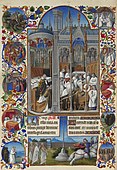
Page of Très Riches Heures du Duc de Berry depictic the funeral of Raymond Diocrès; 1411-1416 and 1485–1486; tempera on vellum; height: 29 cm, width: 21 cm; Condé Museum (Chantilly, France)

The Lady and the Unicorn, the title given to a series of six tapestries woven in Flanders, this one being called À Mon Seul Désir; late 15th century; wool and silk; 377 × 473 cm; Musée de Cluny (Paris)
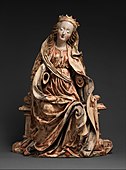
Austrian statue of Enthroned Virgin; 1490–1500; limestone with gesso, painted and gilded; 80.3 × 59.1 × 23.5 cm; Metropolitan Museum of Art

Entrance in Jerusalem; c. 1500; painting; Museum of Fine Arts of Lyon (Lyon, France)
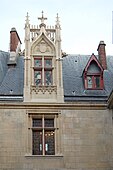
Flamboyant Gothic cross-windows of the Hôtel de Sens (Paris), completed in 1507
Russian and Ukrainian[]
The architectural history of Russia is conditioned by Orthodox Eastern Europe: unlike the West, yet similarly, if tenuously, linked with the traditions of classical antiquity (through Byzantium). It has experienced from time to time westernising movements that culminated in the comprehensive reforms of Peter the Great (around 1700). From prehistoric times the material of vernacular Russian architecture was wood. Byzantine churches and the architecture of Kievan Rus were characterized by broader, flatter domes without a special framework erected above the drum. In contrast to this ancient form, each drum of a Russian church is surmounted by a special structure of metal or timber, which is lined with sheet iron or tiles. Russian architecture used the dome shape not only for churches but also for other buildings. Some characteristics taken from the Slavic pagan temples are the exterior galleries and the plurality of towers.
The use and making of icons entered Kievan Rus' following its conversion to Orthodox Christianity from the Eastern Roman (Byzantine) Empire in 988 CE. As a general rule, these icons strictly followed models and formulas hallowed by usage, some of which had originated in Constantinople. As time passed, the Russians—notably Andrei Rublev and Dionisius—widened the vocabulary of iconic types and styles far beyond anything found elsewhere. The personal, improvisatory and creative traditions of Western European religious art are largely lacking in Russia before the seventeenth century, when Simon Ushakov's painting became strongly influenced by religious paintings and engravings from Protestant as well as Catholic Europe.
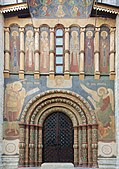
Entrance of the Dormition Cathedral from the Moscow Kremlin (Russia)

Front of a temple pendant with two birds flanking a tree of life; 11th–12th century; cloisonné enamel & gold; overall: 5.4 × 4.8 × 1.5 cm; made in Kyiv (Ukraine); Metropolitan Museum of Art (New York City)
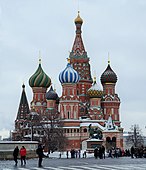
Saint Basil's Cathedral from the Red Square (Moscow). Its extraordinary onion-shaped domes, painted in bright colors, create a memorable skyline, making St. Basil's a symbol both of Moscow and Russia as a whole

Holy Trinity, Hospitality of Abraham; by Andrei Rublev; c. 1411; tempera on panel; 1.1 × 1.4 m; Tretyakov Gallery (Moscow)
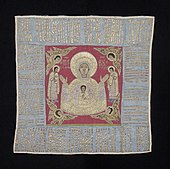
Chalice veil; 16th century; silk, metallic, cotton; 45.7 x 45.7 cm; Metropolitan Museum of Art

Fraternity drinking bowl (endova); 1560–1577; partially gilded silver; height: 15.2 cm, width: 26 cm; Walters Art Museum (Baltimore, USA)

Genealogy of the state of Muscovy; by Simon Ushakov; 1668; tempera on wood; height: 105 cm, width: 62 cm; Tretyakov Gallery

Ukrainian diptych; 1736; silver frame (oclaid), partially gilded; overall: 7.8 × 5.4 × 3.8 cm; Metropolitan Museum of Art
Renaissance[]
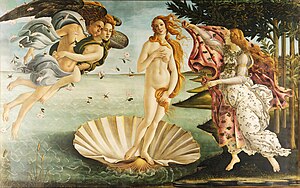
Starting in the 13th century, Italy began to experience a period of great artistic flowering. It is difficult, if not futile, to identify a single impetus for the changes that took place, but a number of factors contributed: a new awareness of antiquity and its distinctiveness, economic prosperity and a coincident sense of competition among patrons and artists, and a newfound awareness of the natural and secular world.
Medieval Europeans didn't perceive a fundamental difference between their own time and antiquity. People were largely indifferent to the scattered vestiges of the past around them, for ancient monuments were familiar to the point of being invisible. Some of these were seen as 'marvels' because of their size or fine carving, but that only made them suspect. The Pantheon in Rome, for example, was said to have been built by demons, and it only survived because it was converted into a church.
The renewed attention to the past as distinct from the present and, more importantly, a desire to revive it, occurred in a series of waves. In the 13th century the Holy Roman Emperor Frederick II (reign 1220–1250), who ruled southern Italy, sought to revive the glories of imperial Rome, including its arts. The sculptor Nicola Pisano learned his craft in that environment before moving north to Tuscany and inspiring local sculptors. In the 14th century the Italian poet Petrarch (1304–1374) postulated a definitive break between the golden age of antiquity and his own time of cultural decline. In the 15th century Leon Battista Alberti (1404–1472), in his treatise On Painting, wrote of the talented artists of antiquity, in comparison to whom living painters and sculptors were 'in no way inferior'. This sense of distance inspired Italians to view the Roman past with fresh eyes, to learn from the accomplishments of the ancients. Competition was also a crucial motivator, as cities, rulers and private individuals strove to outdo one another in their patronage of public and private artworks.[52]
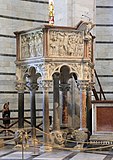
Pulpit; by Nicola Pisano; 1265–1268; marble; height: 4.6 m; Pisa Baptistery (Italy)[31]

The Florence Cathedral (Florence, Italy), by Arnolfo di Cambio, Filippo Brunelleschi and Emilio De Fabris, 1294-1436

The Arnolfini Portrait; by Jan van Eyck; 1434; oil on panel; 82.2 × 60 cm; National Gallery (London)
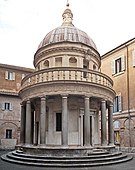
The Tempietto (San Pietro in Montorio, Rome), by Donato Bramante, 1444-1514

Pietà; by Michelangelo; 1498–99; marble; 517 cm × 199 cm; St Peter's Basilica Vatican City

Mona Lisa; by Leonardo da Vinci; c. 1503–1506, perhaps continuing until c. 1517; oil on poplar panel; 77 cm × 53 cm; Louvre

The Garden of Earthly Delights; by Hieronymus Bosch; c. 1504; oil on panel; 2.2 × 1.95 m – the central panel; Museo del Prado (Madrid, Spain)

The School of Athens; by Raphael; 1509–1510; fresco; 5.8 × 8.2 m; Apostolic Palace (Vatican City)

Basin or bowl with a lady named Laura Bella; c. 1510; maiolica (tin-glazed earthenware); overall: 6 × 27.3 cm; Metropolitan Museum of Art (New York City)

The Rhinoceros; by Albrecht Dürer; 1515; woodcut; 23.5 cm × 29.8 cm; National Gallery of Art (Washington, D.C.)

The Ambassadors; by Hans Holbein the Younger; 1533; oil on panel; 2.07 × 2.09; National Gallery (London)

Cassone (chest), with gadroonings; mid 16th century; walnut, carved and partially gilded, coniferous wood; height: 73.6 cm, width: 1.7 m, depth: 63.5 cm; Metropolitan Museum of Art

Oval basin or dish with subject from Amadis of Gaul; c. 1559–1564; maiolica; overall: 6 × 67.3 × 52.4 cm; Metropolitan Museum of Art

Summer; by Giuseppe Arcimboldo; 1563; oil on panel; 67 × 50.8 cm; Kunsthistorisches Museum (Vienna, Austria)
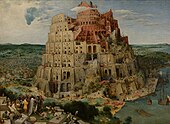
The Tower of Babel; by Pieter Bruegel the Elder; 1563; oil on panel: 1.14 × 1.55 cm; Kunsthistorisches Museum
The Château de Chenonceau (France), by Philibert de l'Orme, 1576
Baroque[]

Baroque appeared at the end of the Renaissance (the 16th century), as a reaction to Classical canons in the next two centuries, the 17th and the 18th. The 17th century was a period of volatile change. Astronomical breakthroughs and scientific inventions such as the telescope and microscope were matched by developments in geography, exploration, natural history and philosophy. Religious upheaval added to the mix, as the Catholic Counter-Reformation contested the growing popularity of Protestant faith. During the Renaissance and Baroque eras, the highest goal of painting was to provide moral exemplars by depicting instructive events from literature, history and mythology. These works are known as history paintings. 17th century history painters were preoccupied with rendering emotion at the most significant moment of a story. This process involved the use of gesture and facial expressions to convey the 'passion of the soul'. This was often combined with a concern for narrative clarity and dramatic concentration, especially in the case of Nicolas Poussin. By such means painters intensified the dramatic impact of narrative scenes, as in Poussin's Abduction of the Sabine Women, in which the horror and fear displayed by the women in contrasted with the aggression and determination of the men, resulting in images of power and terrible beauty.[53]
In decorative and applied arts, Baroque appeared first in the area of present-day Italy, and spread in all Europe. It was a highly ornate and often extravagant style of architecture, music, dance, painting, sculpture and other arts.[54] Main decorative motives include: horns of plenty, festoons, baby angels, lion heads holding a metal ring in their mouths, female faces surrounded by garlands, cartouches, acanthus leaves, classical columns, pediments and other elements of Classical architecture sculpted on some parts of pieces of furniture.[55]

The Four Continents; by Peter Paul Rubens; c. 1615; oil on canvas; 209 x 284 cm; Kunsthistorisches Museum (Vienna, Austria)

The Château de Maisons (France), by François Mansart, 1630–1651
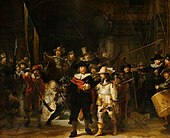
The Night Watch; by Rembrandt; 1642; oil on canvas; 363 × 437 cm; Rijksmuseum (Amsterdam, the Netherlands)
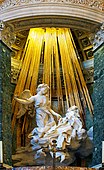
The Ecstasy of Saint Teresa; by Gian Lorenzo Bernini; 1647-1652; marble; height: 3.5 m; Santa Maria della Vittoria (Rome)
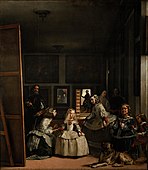
Las Meninas; by Diego Velázquez; 1656-1657; oil on canvas; 318 cm × 276 cm; Museo del Prado (Madrid, Spain)

The Marble Court and facades of the Palace of Versailles (Versailles, France), embellished by Louis Le Vau (1661–1668) and then Hardouin-Mansart in (1679–1681)
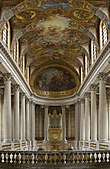
The Royal Chapel, seen from the Royal Gallery of the Palace of Versailles

The Bust of Louis XIV; by Gian Lorenzo Bernini; 1665; marble; 105 × 99 × 46 cm; Palace of Versailles
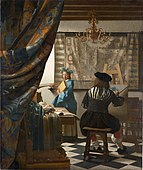
The Art of Painting; by Johannes Vermeer; 1666-1668; oil on canvas; 1.3 x 1.1 m; Kunsthistorisches Museum

French pier table; 1685–1690; carved, gessoed, and gilded wood, with a marble top; 83.6 × 128.6 × 71.6 cm; Art Institute of Chicago (US)[56]

The Portrait of Louis XIV; by Hyacinthe Rigaud; 1701; oil on canvas; 277 × 194 cm; Louvre

The King's Fame Riding Pegasus; by Antoine Coysevox; 1701-1702; Carrara marble; height: 3.15 m, width: 2.91 m, depth: 1.28 m; Louvre
Rococo[]
Delicacy, gaiety, youthfulness and sensuality were the ideals of French Rococo painting. Frivolity was a virtue, and portrait painting was increasingly in demand in a society in which a charming likeness was an essential part of seduction. Primarily a style of surface ornament, the Rococo relegated sculpture and painting to secondary roles and used gilding to compartmentalise walls, mirrors and ornamental panels. This style spread quickly throughout Europe and as far as Ottoman Turkey and China, thanks to ornament books featuring cartouches (curvilinear, often asymmetrical, panels), arabesques (sinuous, interlacing plant-like forms) and shell work, as well as designs for wall panels and fireplaces.[58] French Rococo developed during the Régence (1715-1723), when Louis XV (reign between 1715 and 1774) was a child and the country was governed by Philippe d'Orléans. It grew out of the heavier Baroque style of the court of Louis XIV, incorporating lighter elements, more delicate curves, asymmetry and playfulness.[59] In decorative arts and architecture, it can be recognised by its huge quantity of curves and C-shaped volutes, lightness in colour and weight, or low relief work of ribbons, scrolls, shells, flower wreaths, birds and animals.[60] In France, it enters through the style known as Louis Quinze, here being also known as Pompadour. Unlike Baroque, Rococo abandoned symmetry.[61] This style is seen first in decorative arts and design, but by its height around 1730 it had spread to painting and sculpture. Pan and Venus replaced Apollo and Hercules in a rebirth of gods, goddesses and heroes, and in contrast to the sometimes brooding darkness associated with the Baroque style, a light palette was employed. Three French painters with whom the term Rococo is most often associated are François Boucher, Jean-Antoine Watteau and Jean-Honoré Fragonard.[59]
The term "rococo" comes from the French rocaille, which means "pebble", referring to the organic images that decorate walls and panels, some interiors having a cave-like aspect, like an oval salon in the Hôtel de Soubise from Paris.[62]
The interior of the Hôtel de Soubise in Paris are among the most characteristically elegant and refined examples of the Rococo decorative style. The house is one of the most beautiful 18th-century city mansions in Paris. It was built for the Prince and Princess of Soubise in 1375 and remodelled in 1704 under the instructions of François de Rohan, Prince de Soubise. The building, which is divided into two apartments – that of the Prince on the ground floor and that of the Princess on the upper floor, or piano nobile – features on both floors oval salons that overlook the garden. the salons were created between 1735 and 1739 by Germain Boffrand, a pupil of the French architect François Mansart. Boffrand softened the lines of the Salon Oval de la Princesse with sinuous curves, multiplying the mirror reflection. The walls melt into the vaults, and irregular niches for sculpture are separated by rocaille shells. Architecture, sculpture and painting combine to create a rich and harmonious atmosphere. Eight ceiling canvases painted by Charles-Joseph Natoire between 1737 and 1739 illustrate the story of Cupid and Psyche. Before his return from Italy in 1730, Natoire had spent several years in Rome at the Académie de France, where he had studied the works of Paolo Veronese, Antonio Correggio and, especially, Pietro da Cortona, a 17th-century painter of decorative frescos. Their influence is evident in the supple and elegant compositions, the lighting effects, and the way the figures are adapted to the constraints of the decor. The palette of pinks, blues and greens creates a charming arcadian effect, encapsulating the mature Rococo.[57]
The Portuguese were the first Europeans to trade directly with the nations of East Asia, shortly after finding a direct route around Africa in 1498. Britain and Holland followed suit just over a century later with the foundation of their East India companies – Protestant challenges to Portugal's power and Chinese porcelains, Indian textiles and Japanese lacquers flooded the markets of Amsterdam and London. These items were sought after as objects of prestige, symbolic not only for personal wealth but also of the influence of the nations able to import them. European imaginations were fuelled by perceptions of Asia as a place of wealth and luxury, and consequently patrons from emperors to merchants vied with each other in adorning their living quarters with Asian goods and decorating them in Asian styles. Where Asian objects were hard to obtain, European craftsmen and painters stepped up to fill the breach, creating a blend of Rococo forms and authentic Asian figures, motifs and techniques. The vogue for Chinoiserie was ubiquitous: Asian-inspired interiors swept over Europe from Sweden to Sicily and flourished in the Americas from New England to New Spain (Mexico), Brazil to Argentina.[63]
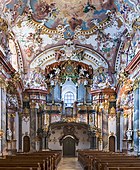
The amazing interior of the Wilhering Abbey (Wilhering, Austria). This interior has a trompe-l'œil on its ceiling, surrounded of highly decorated stuccos

Boiserie from the Hôtel de Varengeville; c. 1736-1752; various materials, including carved, painted, and gilded oak; height: 5.58 m, width: 7.07 m, length: 12.36 m; in the Metropolitan Museum of Art (New York City)
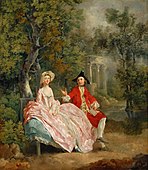
Conversation in a Park; by Thomas Gainsborough; 1746; oil on canvas; 73 × 68 cm; Louvre

Wall elevation with a secretaire, from 'Schreibtische'; by Johann Georg Hertel; 1748-1770; etching; 29.7 × 19.1 cm; Metropolitan Museum of Art
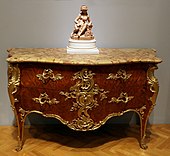
Chest of drawers; c. 1750; oak, tulipwood marquetry, gilt metal mounts and marble; overall: 88 x 156.5 x 69.9 cm; Cleveland Museum of Art (Cleveland, Ohio, US)

Candelabrum; by Jean Joseph de Saint-Germain; c. 1750; gilt bronze; overall: 72.4 x 49.3 x 39.7 cm; Cleveland Museum of Art

Madame de Pompadour; by François Boucher; 1756; oil on canvas; 2.01 x 1.57 m; Alte Pinakothek (Munich, Germany)

The Ark of the Covenant, from Book of Cartouches; by François Boucher; mid-18th century; etching and engraving (reverse copy); sheet (trimmed): 30 × 19.8 cm; Metropolitan Museum of Art

Covered tureen (terrine du roi); 1756; soft-paste porcelain with enamel and gilt decoration; overall: 24.2 cm, the container: 15.9 x 22.6 x 16.5 cm; Cleveland Museum of Art
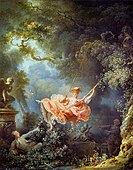
The Swing; by Jean-Honoré Fragonard; 1767–1768; oil on canvas; height: 81 cm, width: 64 cm; Wallace Collection (London)

The coiffure; made by the Ludwigsburg Porcelain Manufactory; c. 1770; hard-paste porcelain; overall: 12.4 × 9.8 × 7 cm; Metropolitan Museum of Art
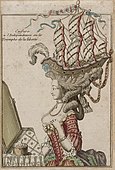
Coiffure à l’Indépendance ou Le Triomphe de la Liberté; 1778; engraving; (Blérancourt, France). In this print a fashionable aristocratic woman is applying the finishing touches to her toilette[64]
Neoclassicism[]

The revival of Classical styles in the second half of the 18th century was in some ways a reaction against the perceived frivolity and decadence of the Rococo. It was stimulated by the rediscovery of the ancient sites of Pompeii and Herculaneum, which inspired a fascination with Greek and Roman antiquity and influenced all the arts, from painting and sculpture to architecture, fashion, literature and music.
The most original phase of Neoclassicism can be associated with the French Revolution of 1789–1799, when artists and architects drew overt comparisons between their desire for Liberté, Egalité et Fratenité and what they understood to be the political principles of Classical Rome and Greece.[65] The Empire style is representative of the new French society emerging from the revolution that set the tone in all areas of life, including art. This style has introduced the concept of industrial production in decorative art. Other Neoclassical styles include: Adam (English) and the Federal (American). Motifs widely used in Neoclassical applied art are: pediments, acanthus leaves, palmettes, festoons, cartouches, ancient trophies and musical instruments, griffins, chimeras, sphinxes, horns of abundance, lion heads holding a metal ring in their mouths and sometimes winged women.[66] Most of them are taken from Greek, Etruscan or Roman objects, interiors and architecture; but some of them, like the cartouche are from the Renaissance.
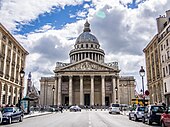
The Panthéon from Paris, built in 1758-1790, by Jacques-Germain Soufflot (1713-1780) and Jean-Baptiste Rondelet (1743-1829)
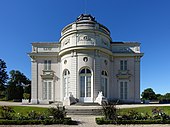
Château de Bagatelle from Paris, a small Neoclassical château, built in 1777, by François-Joseph Bélanger
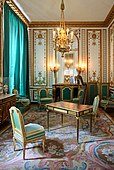
The Salon Doré of Marie Antoinette, in the Palace of Versailles (France), an example of a Louis XVI room

The ancient Capitol ascended by approximately one hundred steps . . .; by Giovanni Battista Piranesi; c. 1750; etching; size of the entire sheet: 33.5 × 49.4 cm; Metropolitan Museum of Art (New York City)

Sybil Temple, Izabela Czartoryska's first museum at Pulawy, built in c. 1775, by Piotr Aigner (Poland)
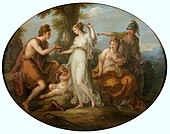
The Judgment of Paris; by Angelica Kauffman; c. 1781; oil on canvas;100.9 × 80 cm; Museo del Ponce (Puerto Rico)

Oath of the Horatii; by Jacques-Louis David; 1784; oil on canvas; height: 330 cm, width: 425 cm; Louvre

The Death of Socrates; by Jacques-Louis David; 1787; oil on canvas; 129.5 cm × 196.2 cm; Metropolitan Museum of Art
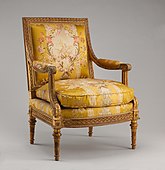
Armchair (fauteuil) from Louis XVI's Salon des Jeux at Saint Cloud; 1788; carved and gilded walnut, gold brocaded silk (not original); overall: 100 × 74.9 × 65.1 cm; Metropolitan Museum of Art

Girl with a dove; by Anna Rajecka; 1789–1790; pastel on paper; 64 × 53 cm; National Museum (Warsaw, Poland)

Double door, with Greek and Roman ornaments on it; by Pierre Rousseau; 1790s; oil on panel; framed: 287 × 154 × 6 cm, unframed: 274 × 63 cm; Cleveland Museum of Art (Cleveland, Ohio, US)

Coffee cup with saucer; c. 1790; jasper ware with relief decoration; diameter: 13.6 cm; by the Wedgwood Factory (England); Cleveland Museum of Art

Perseus with the head of Medusa; by Antonio Canova; 1804–1806; marble; height: 242.6 cm, width: 191.8 cm, depth: 102.9 cm; Metropolitan Museum of Art

Venus Victrix; by Antonio Canova; 1805–1808; marble; Galleria Borghese (Rome)

Clock with Mars and Venus; c. 1810; gilded bronze and patina; height: 90 cm; Louvre

Dining room of the Centralhotel (Berlin), designed in 1881 by von der Hude & Hennicke
Western art after 1770[]

Many art historians place the origins of modern art in the late 18th century, others in the mid 19th century. Art historian H. Harvard Arnason stated "a gradual metamorphosis took place in the course of a hundred years."[67] Events such as the age of enlightenment, revolutions and democracies in America and France, and the Industrial Revolution had far reaching affects in western culture. People, commodities, ideas, and information could travel between countries and continents with unprecedented speed and these changes were reflected in the arts. The invention of photography in the 1830s further altered certain aspects of art, particularly painting. By the dawn of the 19th century, a long and gradual paradigm shift was complete, from the Gothic when artists were viewed as craftsmen in the service of the church and monarchies, to the idea of art for art's sake, where the ideas and visions of the individual artist were held in the high regard, with patronage from an increasingly literate, affluent, and urban middle and upper class population that had been emerging for 200 years (particularly in Paris and London). A dichotomy begin in the late 18th century between neoclassicism and romanticism that subdivided and continued to run through virtually every new movement in modern art: "Spreading like waves, these "isms" defy national, ethnic, and chronological boundaries; never dominant anywhere for long, they compete or merge with each other in endlessly shifting patterns."[68]
Modern art has consistently moved toward international influences and exchanges, from the exotic curiosity of Orientalism, the deeper influence of Japonisme, to the arts of Oceania, Africa, and the Americas. Conversely modern art has increasingly extended beyond western Europe. In Russia and the USA the arts were developing to a degree that rivaled the leading European countries by the end of the 19th century. Many of the major movements appeared in Latin America, Australia, and Asia too and geography and nationality became increasingly insignificant with each passing decade. By the 20th century important and influential artist were emerging around the world: e.g. Foujita (Japan), Arshile Gorky (Armenia), Diego Rivera and Frida Kahlo (Mexico), Wifredo Lam (Cuba), Edvard Munch (Norwegian), Roberto Matta (Chilean), Mark Rothko (Lithuanian-American), Fernando Botero Angulo (Colombia), Constantin Brâncuși and Victor Brauner (Romania).[69][70][71][72][73]

Newton's Cenotaph, exterior by night; by Étienne-Louis Boullée; 1784; ink and wash, 40.2 × 63.3 cm.; Bibliothèque Nationale

The Dog; Francisco de Goya; ca. 1819–1823; mural transferred to canvas, 131.5 × 79.3 cm.; Museo del Prado
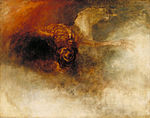
Death on a Pale Horse; J. M. W. Turner; c. 1830; oil on canvas, 60 × 76 cm.; Tate Britain
Toothless Man Laughing, Charles Philipon form Célébrités du Juste milieu; Honoré Daumier; 1832–33; painted clay, 6.12 high; Musée d'Orsay

Still life with statue of Jupiter Tonans; by Louis Jacques Daguerre; c. 1839; daguerreotype
19th century[]
Romanticism (c. 1770–1860)[]

Romanticism emerged in the late 18th century and flourished in the first half of the 19th century with significant and international manifestations in music, literature, poetry, and architecture, as well as the visual arts. One of the earliest expressions of romanticism was in the English landscape garden, carefully designed to appear natural and standing in dramatic contrast to the formal gardens of the time. The concept of the "natural" English garden was adopted throughout Europe and America in the following decades. In architecture, the romantics frequently turned to alternative sources other than the Greek and Roman examples admired by the neo-classicist. Romantic architecture often revived Gothic forms and other styles such as exotic eastern models. The Palace of Westminster (Houses of Parliament), London is an example of romantic architecture that is also referred to as Gothic Revival.[74] In painting romanticism is exemplified by the paintings of Francisco Goya in Spain, Eugène Delacroix and Théodore Géricault in France, William Blake, Henry Fuseli, Samuel Palmer, and William Turner in England, Caspar David Friedrich and Philipp Otto Runge in Germany, Francesco Hayez in Italy, Johan Christian Claussen Dahl in Norway, and Thomas Cole in America. Examples of sculptors of the romantic period include Antoine-Louis Barye, Jean-Baptiste Carpeaux, Auguste Préault, and François Rude. As romanticism ran its course, some aspects of the movement evolved into symbolism.[72][75][76]
"Neoclassicism is a new revival of classical antiquity.....while Romanticism refers not to a specific style but to an attitude of mind that may reveal itself in any number of ways."[74] Romanticism often attempts to address the viewer through the heart and psyche, evoking passions and emotions, often reflecting on mankind's relationship and place in nature in the industrial revolution; in contrast to the symmetry, rational, "cult of reason"[77] of Neoclassicism.[75][72]
The Nightmare; by John Henry Fuseli; 1781; oil on canvas; 101.6 × 127 cm; Detroit Institute of Arts

Newton; by William Blake; 1795; color print, pen & ink, watercolor; 46 × 60 cm; Tate Britain

The Third of May 1808; by Francisco Goya; 1814; oil on canvas; 2.6 × 3.4 m; Museo del Prado

The Raft of the Medusa; Théodore Géricault; 1818–1819; oil on canvas; 491 × 716 cm; Louvre

The Sea of Ice; by Caspar David Friedrich; 1823–1824; oil on canvas; 97 × 127 cm; Kunsthalle Hamburg

The Death of Sardanapalus; by Eugène Delacroix; 1827; oil on canvas; 3.9 × 4.9 m; Louvre

The Goethe Monument; by Carl Gustav Carus; 1832; oil on canvas; 71 × 52.2 cm; Kunsthalle Hamburg

Slave Ship (Slavers Throwing Overboard the Dead and Dying, Typhoon Coming On); by J. M. W. Turner; 1840; oil on canvas (90.8 × 122.6 cm.); Museum of Fine Arts Boston

Houses of Parliament; by Sir Charles Barry and A. Welby Pugin; begun in 1836; London

Ugolino and His Sons; by Jean-Baptiste Carpeaux; 1857–60; Marble; 197.5 × 149.9 × 110.5 cm; Metropolitan Museum of Art
Realism (c. 1840–1880)[]

Realism emerged in the mid-nineteenth century, c. 1840, and had counterparts in sculpture, literature, and drama, often referred to as Naturalism in literature. In nineteenth-century painting, the term Realism refers more to the subject matter depicted than to the style or technique. Realist paintings typically represent ordinary places and people engaged in everyday activities, as opposed to grand, idealized landscapes, mythological gods, biblical subjects, and historical figures and events that had often dominated painting in western culture. Courbet said "I cannot paint an angel because I have never seen one".[74]
Realism was also in part a reaction to the often dramatic, exotic, and emotionally charged work of romanticism. The term realism is applied relative to the idealized imagery of neo-classicism and the romanticized imagery of romanticism. Artists such as Jean-Baptiste-Camille Corot and Honoré Daumier had loose associations with realism, as did members of the Barbizon School, particularly Jean-François Millet, but it was perhaps Gustave Courbet who was the central figure in the movement, self identifying as a realist, advocating realism, and influencing younger artists such as Édouard Manet. One significant aspect of realism was the practice of painting landscapes en plein air and its subsequent influence on impressionism.
Beyond France, realism is exemplified by artists such as Wilhelm Leibl in Germany, Ford Madox Brown in England, and Winslow Homer in the United States. Art historian H. H. Arnason wrote, "The chronological sequence of neo-classicism, romanticism, and realism is, of course, only a convenient stratification of movements or tendencies so inextricably bound up with one another and with the preceding movements that it is impossible to tell where one ended and another began",[78] and this becomes even more pertinent and complex as one follows all of the movements and "isms" into the late 19th and early 20th centuries.[79][80][81][81][82]

Saint-André-en-Morvan; by Jean-Baptiste-Camille Corot; 1842; oil on canvas; 31 × 59 cm; Louvre

Pool in the Forest; by Théodore Rousseau; early 1850s; oil on canvas; 39.4 × 57.4 cm; Museum of Fine Arts

The Last of England; by Ford Madox Brown; 1852–1855; oil on panel; height: 82.5 cm, width: 75 cm; Birmingham Museum and Art Gallery

Third Class Carriage; by Honorè Daumier; 1856–1858; oil on panel; 26 × 33.9 cm; Museum of Fine Arts

The Absinthe Drinker; by Édouard Manet; 1859; oil on canvas; 18.05 × 10.56 mm; Ny Carlsberg Glyptotek

The Goosegirl; by Jean-François Millet; 1866–67; oil on canvas; 45.7 × 55.9 cm; Tokyo Fuji Art Museum

Artists Sketching in the White Mountains; by Winslow Homer; 1868; oil on panel; 24.1 cm × 40.3 cm; Portland Museum of Art

Three Women in Church; by Wilhelm Leibl; 1882; oil on mahogany wood; height: 113 cm, width: 77 cm; Kunsthalle Hamburg

Feast of Trumpets; by Aleksander Gierymski; 1884; oil on canvas; 47 × 64.5 cm; National Museum, Warsaw

A Negress; by Anna Bilińska-Bohdanowicz; 1884; oil on canvas; 63 × 48.5 cm; National Museum, Warsaw
Impressionism (c. 1860–1890)[]
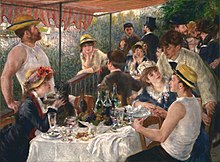
Impressionism emerged in France, under the influences of Realism, the Barbizon School, and en plein air painters like Eugène Boudin, Camille Corot, Charles- Francois Daubigny, and Johan Barthold Jongkind. Starting in the late 1850s, several of the impressionists had made acquaintances and friendships as students in Paris, notably at the free Académie Suisse and Charles Gleyre's studio. Their progressive work was frequently rejected by the conservative juries of the prestigious Académie des Beaux Arts salons, a forum where many artist turned to establish their reputations, and many of the young artist were included in a highly publicized, but much ridiculed Salon des Refusés in 1863. In 1874 they formed the Société Anonyme Coopérative des Artistes Peintres, Sculpteurs, Graveurs, independent of the academy, and mounted the first of several impressionist exhibitions in Paris, through to 1886 when their eighth and final exhibition was held. Important figures in the movement included Frédéric Bazille, Gustave Caillebotte, Mary Cassatt, Paul Cézanne, Edgar Degas, Armand Guillaumin, Édouard Manet, Claude Monet, Berthe Morisot, Camille Pissarro, Pierre-Auguste Renoir, and Alfred Sisley. Although impressionism was primarily a movement of painters, Degas and Renoir also produced sculptures and others like Auguste Rodin and Medardo Rosso are sometimes linked to impressionism. By 1885 impressionism had achieved some prominence, and yet a younger generation were already pushing the limits beyond impressionism. Artist from Russia, Australia, America and Latin America soon adopted impressionist styles. A few of the original impressionist continued producing significant work into the 1910s and 1920s.[80][83][84]
Although not unprecedented, many of the techniques used were in contrast to traditional methods. Paintings were often completed in hours or days with wet paint applied to wet paint (opposed to wet on dry paint, completed in weeks and months). Rather than applying glazes and mixed colors, pure colors were often applied side by side, in thick, opaque, impasto strokes; blending in the eye of the viewer when observed from a distance. Black was used very sparingly, or not at all, and defining lines replaced with nuanced strokes of color forming the subjects, contours, and shapes. Art historian H. W. Janson said "instead of adding to the illusion of real space, it strengthens the unity of the actual painted surface."[74] Impressionist paintings typically depict landscapes, portraits, still lifes, domestic scenes, daily leisure and nightlife, all treated in a realist manner. Compositions were often based on unusual perspectives, appearing spontaneous and candid. The paintings were usually void of didactic, symbolic, or metaphoric meanings, and rarely addressed the biblical, mythological, and historical subjects that were so highly regarded by the academies or the darker and psychological interest explored by the symbolist. The nuances of light, shadow, atmosphere, and reflections of colors from surfaces were examined, sometimes emphasizing changes of these elements in time. The painting itself was the subject of the painting. It was art for art's sake, an idea that had been floating around for a few of decades but it perhaps reached a new high and consistency in impressionism.[71][80][83][84]
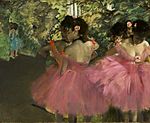
Dancers in Pink; Edgar Degas; 1867; oil on canvas; 59 × 74 cm; Hill–Stead Museum (Farmington

View of the Village; by Frédéric Bazille; 1868; oil on canvas, 130 × 89 cm.; Musée Fabre

Soleil couchant à Ivry; by Armand Guillaumin; 1873; oil on canvas; 65 × 81.0 cm; Musée d'Orsay
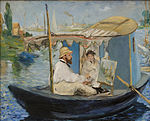
Claude Monet Painting in his Studio; by Édouard Manet; 1874; oil on canvas; 80 × 98 cm; Neue Pinakothek
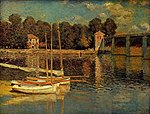
The Railway Bridge at Argenteuil; by Claude Monet; 1874; oil on canvas; 60 × 80 cm; Musée d'Orsay

Mademoiselle Boissière Knitting; by Gustave Caillebotte; 1877; oil on canvas; 65 × 80 cm; Museum of Fine Arts, Houston

Bowl with Apples; by Paul Cézanne; 1878–79; oil on canvas; 45.5 × 55 cm; Annenberg Collection

Summer-day: Lake in the Bois de Boulogne; by Berthe Morisot; 1879; oil on canvas; 45.7 × 75.2 cm; National Gallery

Banks of the Seine at By; by Alfred Sisley; ca. 1880–81; oil on canvas; 54.3 × 73.3 cm; Clark Art Institute (Williamstown, Massachusetts)
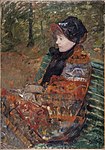
Autumn, Lydia Cassatt; Mary Cassatt; 1880; oil on canvas; 92.5 × 65.5 cm; Petit Palais

The Loge; by Pierre-Auguste Renoir; 1881; oil on canvas; 127 × 92 cm; Courtauld Institute of Art

A Bar at the Folies-Bergère; by Édouard Manet; 1881–82; oil on canvas, 96 × 130 cm.; Courtauld Institute of Art
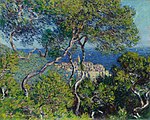
Bordighera; by Claude Monet; 1884; oil on canvas, 81 × 65 cm.; Art Institute of Chicago

Rue Saint-Honoré, dans l'après-midi. Effet de pluie; by Camille Pissarro; 1898; oil on canvas, 73.6 × 91.4 cm.; Minneapolis Institute of Art

Water Lilies, Morning; by Claude Monet; ca. 1914–24; oil on canvas, 2,000 × 12,750 mm; Musée de l'Orangerie
Symbolism (c. 1860–1915)[]

Symbolism emerged in France and Belgium in the 3rd quarter of the nineteenth century and spread throughout Europe in the 1870s, and later to America to a lesser extent. It evolved from romanticism without a clear or defining demarcation point, although poetry, literature, and specifically the publication of Charles Baudelaire's Les Fleurs du mal (The Flowers of Evil) in 1857 were significant in the development of symbolism. It had international expression in poetry, literature, drama, and music. In architecture, the applied arts, and decorative arts symbolism closely paralleled and overlapped into Art Nouveau. Symbolism is often inextricably linked to other contemporary art movements, surfacing and finding expression within other styles like Post-Impressionism, Les Nabis, the Decadent Movement, the Fin-de Siecle, Art Nouveau, The Munich Secession, The Vienna Secession, Expressionism, and even the Pre-Raphaelites, which had formed before and influenced symbolism as well. Artist as diverse as James McNeill Whistler, Eugène Carrière, Ferdinand Hodler, Fernand Khnopff, Giovanni Segantini, Lucien Lévy-Dhurmer, Jean Delville, and James Ensor all had varying degrees of association with symbolism. Art historian Robert L. Delevoy wrote "Symbolism was less a school than the atmosphere of a period."[85] It quickly began to fade with the onset of Fauvism, Cubism, Futurism and had largely dissipated by the outbreak of the First World War, however it did find some sustained development and relevance in the metaphysical school, which in turn had a profound influence on surrealism.[85][71][86]
The subjects, themes, and meanings of symbolist art are frequently veiled and obscure, but at its best still manage to resonate deeply on psychological or emotional levels. The subjects are often presented as metaphors or allegories, aiming to evoke highly subjective, personal, introspective emotions and ideas in the viewer, without clearly defining or addressing the subject directly. The poet Stéphane Mallarmé wrote "depict not the thing but the effect it produces"[87] and "To name an object is to suppress three quarters of the pleasure of the poem which is made to be understood little by little".[86] The English painter George Frederic Watts stated "I paint ideas, not things."[85][71][86]
The Carrier Pigeon; by Pierre Puvis de Chavannes; 1871; oil on canvas; 136.7 × 86.5 cm; Musée d'Orsay

Pornocrates; by Félicien Rops; 1878; watercolor, gouache and pastel; 75 × 48 cm; Musée Félicien Rops (Namur, Belgium)

Entführung [Abduction]; by Max Klinger; 1891; etching and aquatint; 11,9 × 26,9 cm; Albertina
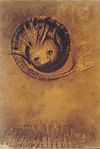
Chimera; by Odilon Redon; 1883; charcoal and black chalk on paper; 50,4 × 34 cm; Kröller-Müller Museum

Andromeda (previous title Danaid); by Auguste Rodin; 1886; marble; 29 × 32 × 20 cm; Museo Nacional de Bellas Artes

Isle of the Dead (5th. version); by Arnold Böcklin; 1886; oil on panel (80.7 × 150 cm.); Museum der bildenden Künste

O grave, where is thy Victory; Jan Toorop; 1892; pencil and chalk; 60.4 × 75.3 cm; Rijksmuseum

The Sin; by Franz von Stuck; 1893; oil on canvas; 94.5 × 59.5 cm; Neue Pinakothek
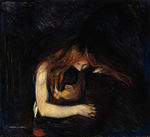
Love and Pain; by Edvard Munch; 1894; oil on canvas; 100 × 110 cm; Munch Museum

The Race Track (Death on a Pale Horse); by Albert Pinkham Ryder; from 1896 to 1908; oil on canvas; 70.5 × 90 cm; Cleveland Museum of Art

Where Do We Come From? What Are We? Where Are We Going?; by Paul Gauguin; 1897; oil on canvas; 141 × 376 cm; Museum of Fine Arts
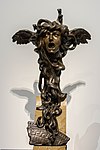
Medusa; by Fernand Khnopff; 1900; bronze, marble base; Fin de Siècle Museum (part of the Royal Museums of Fine Arts of Belgium

The Lady on the Horse; by Alfred Kubin; 1901; pen, ink, wash and spray; 39.7 × 31 cm

The Demon Downcast; by Mikhail Vrubel; 1902; State Tretyakov Gallery

The Three Ages of Woman; by Gustav Klimt; 1905; oil on canvas; 180 × 180 cm; Galleria Nazionale d'Arte Moderna e Contemporanea
Arts and Crafts movement (c. 1860–1915)[]

The Arts and Crafts movement mostly worked in architecture and the decorative arts, where it promoted traditional craftsmanship, the use of locally available materials, and integrity in the way in which things were made. It began in the late-19th century Britain, when writers such as John Ruskin and William Morris rejected mass-production and the often poor quality, machine-made items that were found in many homes and shops. Morris, in particular, believed in the importance of the individual craftsman, and advocated a return to hand craftsman, which, he argued, would not only produce better furniture, pottery, textiles, and other items, but would also help people to lead better, more fulfilling lives. Mass-production, he maintained, was responsible for a decline in values. Many Arts and Crafts designers drew upon the influence of medieval craftsmanship, and their objects and interiors exploited the distinctive qualities of natural materials, from beautifully finished oak to hand-woven tapestries. Others, however, looked further afield for inspiration, incorporating vivid colours inspired by Islamic art, or ancient Egyptian motifs in their work. Knots, swirls, Celtic crosses, and entrelac (interlanced designs) inspired by ancient Celtic art featured in the work of many Arts and Craftsdesigners, notably Archibald Knox, especially on metalwork.
Widely exhibited in Europe, the Arts and Crafts style's simplicity inspired artists such as Carl Larsson and wife, Karin Bergöö Larsson, designers like Henry van de Velde and styles such as Art Nouveau, the Dutch De Stijl group, Vienna Secession, and eventually the Bauhaus style. Nikolaus Pevsner regarded the style as a prelude to Modernism, which used simple forms without ornamentation.[88] The Vienna Secession encouraged in part Central European artists and writers under Habsburg rule to return to their national and folk roots. In Poland this gave rise to the flowering of "Młoda Polska" (Young Poland), whose noted exponents included Jacek Malczewski, Jan Stanisławski, Józef Mehoffer, Józef Pankiewicz, Leon Wyczółkowski, Olga Boznańska, Stanisław Wyspiański, Wojciech Gerson and Wojciech Kossak.[89]

Girl on garden bench; by Olga Boznańska; 1896; oil on cardboard; 65.5 cm × 42.5 cm; National Museum of Poland (Warsaw)

The Well at the World's End; by William Morris and Edward Burne-Jones; 1896; illustrations: woodcuts; one of eight vellum bound copies; 28.9 × 21 × 5.1 cm; Metropolitan Museum of Art

Villa pod Jedlami; designed by Stanisław Witkiewicz; 1890s; timber and glass; Zakopane Style Zakopane

Self-portrait; by Stanisław Wyspiański; 1902; pastel on paper; 37.5 cm × 36.8 cm; National Museum of Poland
Nietzsche Archive Extension; by Henry van de Velde; 1903; Weimar (Germany)

Dropfront desk; by Gustav Stickley; c. 1903; oak with copper hardware; 130.8 × 65.4 × 27.6 cm; Brooklyn Museum

Azalea; by Carl Larsson; 1906; Thiel Gallery

Sun in May; by Józef Mehoffer; 1911; oil on canvas; 95 cm × 78 cm; National Museum of Poland
Post-Impressionism (c. 1885–1905)[]

Post-Impressionism is a rather imprecise term applied to a diverse generation of artists. In its strictest sense, it pertains to four highly influential artists: Paul Cézanne,[90][91] Paul Gauguin,[92][93] Georges Seurat,[94][95] and Vincent van Gogh.[96][97] Each passed through an impressionist phase, but ultimately emerged with four very original but different styles. Collectively, their work anticipated, and often directly influenced, much of the avant-garde art that appear before the First World War including fauvism, cubism, expressionism, and early abstraction. Cézanne (particularly influential on cubism) and Van Gogh worked in relative isolation, away from Paris, at critical points in their careers, while Seurat and Gauguin worked in groups, more collaboratively, at key points in their development. Another important artist of the period is Toulouse-Lautrec, an influential painter as well as graphic artist.[98][99] In a broader sense, post-impressionism includes a generation of predominantly French and Belgian artist who worked in a range of styles and groups. Most had come under the sway of impressionism at some point, but pushed their work beyond it into a number of factions as early as the mid 1880s, sometimes as a logical development of impressionism, other times as a reaction against it. Post-Impressionists typically depicted impressionist subjects, but the work, particularly synthetism, often contained symbolism, spiritualism, and moody atmospheres that rarely appeared in impressionism. Unnatural colors, patterns, flat plains, odd perspectives and viewpoints pushed to extremes, all moved the center of modernism a step closer to abstraction with a standard for experimentation.[78][100][101]
Neo-Impressionism (Divisionism or Pointillism, c. 1884–1894) explored light and color based on scientific color theories, creating mosaics of brush strokes in pure colors, sometimes laid out in rhythmic patterns with lines influenced by Art Nouveau. The leading artists were Georges Seurat and Paul Signac, others include Henri-Edmond Cross, Maximilien Luce, Albert Dubois-Pillet, and for a period Pissarro and Van Gogh. It was influential on fauvism, and elements of the style appeared in expressionism, cubism, and early abstraction. Synthetism (Cloisonnism c. 1888–1903) Cloisonnism was conceived by Émile Bernard and immediately taken up and developed by Paul Gauguin and others while at an artists' colony in Pont-Aven (Brittany, France). The style resembled cloisonné enamel or stained glass, with flat, bold colors outlined in black or dark colors. Synthetism, exemplified in the work of Gauguin and Paul Sérusier, is slightly a broader term with less emphasis on dark outlines and cloisonné qualities. Other artist include Cuno Amiet, Louis Anquetin, Charles Filiger, Jacob Meyer de Haan, Charles Laval, and Armand Seguin. Their work greatly influenced fauvism and expressionism. Les Nabis (c. 1890–1905: Hebrew for prophets or illuminati) was a larger movement in France and Belgium that eclectically drew on progressive elements in synthetism, neo-impressionism, symbolism, and Art Nouveau. Perhaps more influential than the art, were the numerous theories, manifestoes, and infectious enthusiasm for the avant-garde, setting the tone for the proliferation of movements and "isms" in the first quarter of the 20th century. La Revue Blanche often published Les Nabis and symbolist content. The work of Édouard Vuillard,[102][103] and Pierre Bonnard,[104][105] ca. 1890–1910 is exemplary of Les Nabis, though both evolved in their styles and produced significant work into the 1940s. Other artist include Maurice Denis, Maxime Dethomas, Meyer de Haan, Henri-Gabriel Ibels, Georges Lacombe, Aristide Maillol, Paul Ranson, Ker-Xavier Roussel, Armand Séguin, Paul Sérusier, Félix Vallotton, Jan Verkade, and others.[78][100][101]

Models (Les Poseuses); by Georges Seurat; 1886–1888; oil on canvas; 200 × 249.9 cm; Barnes Foundation

Sunset, Herblay, Opus 206; by Paul Signac; 1889; oil on canvas, 57 × 90 mm.; Kelvingrove Art Gallery and Museum

Mont Sainte-Victoire; by Paul Cézanne; 1904–06; oil on canvas, 65 × 81 cm.; Philadelphia Museum of Art

The Starry Night; by Vincent van Gogh; 1889; oil on canvas; height: 73.7 cm; Museum of Modern Art
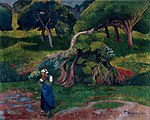
Landscape at Le Pouldu; by Paul Sérusier; 1890; oil on canvas, 74 × 92 cm; Museum of Fine Arts, Houston

Ia Orana Maria (We Greet Thee, Mary); by Paul Gauguin; 1891; oil on canvas, 114 × 89 cm.; Metropolitan Museum of Art

The Green Trees 'or' The Beeches of Kerduel; by Maurice Denis; 1893; oil on canvas, 46 × 43 cm.; Musée d'Orsay, Paris

Figures in the Street; by Pierre Bonnard; ca. 1894; oil on paper, 24 × 25.5 cm.; Private collection
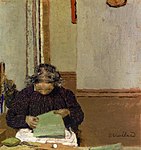
Madame Vuillard Cousant or Old Lady Examining her Needlework; by Édouard Vuillard; 1893; oil on board, 29.2 × 27.9 cm.; Private collection

The Mediterranean; by Aristide Maillol; 1902–03; bronze, 104 cm. high; Museum Boijmans van Beuningen
Early 20th century[]
The history of 20th-century art is a narrative of endless possibilities and the search for new standards, each being torn down in succession by the next. The art movements of Fauvism, Expressionism, Cubism, abstract art, Dadaism and Surrealism led to further explorations of new creative styles and manners of expression. Increasing global interaction during this time saw an equivalent influence of other cultures into Western art, such as Pablo Picasso being influenced by Iberian sculpture, African sculpture and Primitivism. Japonism, and Japanese woodcuts (which had themselves been influenced by Western Renaissance draftsmanship) had an immense influence on Impressionism and subsequent artistic developments. The influential example set by Paul Gauguin's interest in Oceanic art and the sudden popularity among the cognoscenti in early 20th century Paris of newly discovered African fetish sculptures and other works from non-European cultures were taken up by Picasso, Henri Matisse, and many of their colleagues. Later in the 20th century, Pop Art and Abstract Expressionism came to prominence.
Russian Revival sideboard; by ; 1903; Musée d'Orsay

The from Bucharest (Romania), 1906–1914, built to the design of the architect , in the French Neoclassical style
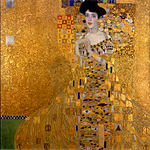
Portrait of Adele Bloch-Bauer I, an Art Nouveau masterpiece; by Gustav Klimt; 1907; oil, silver, and gold on canvas; 140 × 140 cm; Neue Galerie New York

The Kiss; by Constantin Brâncuși; 1907; stone; height: 28 cm; Craiova Art Museum

The Dream; by Henri Rousseau; 1910; oil on canvas; 204.5 × 298.5 cm; Museum of Modern Art

Female head; by Amedeo Modigliani; 1912; limestone; height: 68.3 cm, width: 15.9 cm, depth: 24.1 cm; Metropolitan Museum of Art

The Violinist; by Marc Chagall; 1912–1913; oil on checked tablecloth; 1.88 × 1.58 m; Stedelijk Museum Amsterdam

Baroque Revival house in Bucharest, built in 1920
Art Nouveau (c. 1890–1915)[]

Art Nouveau is an international style of art, architecture and applied art, especially the decorative arts, characterised by its two main sources of inspiration: use of plant-shaped ornaments (sinuous curves); and historical art styles (like Gothic, Celtic, Byzantine, Rococo and Baroque), especially Japanese art.
The cult of nature, with its sinuous curves and tendrils of ivy that almost appear to take root within an item of furniture or decorative arts, was a popular theme for Art Nouveau. It was through this medium that women were most often portrayed as stylised objects rather than people. Through the use of nature as an idiom, designers hoped to incorporate all aspects of life into a single object or interior: the outside was brought inside and the human relationship with the environment was explored.
In Spain, Italy, Russia and the US artists and designers added to the novel and fascinating interpretations of Art Nouveau. Every culture drew on different sources of inspiration including Gothic, Celtic, Byzantine, Rococo and Baroque. While historical influences were present they could not be justified unless they were approached with innovation rather than tradition. The portrayal of women in art at the turn of the century highlights another important challenge to contemporary societies. In many instances women were depicted as fantasy figures, interplaying with nature, united with it. By contrast, the gritty realism of paintings by Henri de Toulouse-Lautrec demonstrated that women could be portrayed as genuine people involved in mundane aspects of their daily lives.[106]
The earliest influences of Art Nouveau began to emerge in England among figures such as John Ruskin, the Pre-Raphaelite Brotherhood, Edward Burne-Jones, William Morris and the Arts and Crafts Movement, which paralleled some aspects of symbolist sensibilities in France and Belgium at that time. Art Nouveau is closely allied and intermingled with symbolism. The term Art Nouveau is most often applied to architecture, crafts, and decorative arts, while symbolism is more commonly used for fine arts like painting and sculpture as well as poetry and literature, however there are no hard, defining lines between the two. Art Nouveau was an international movement that spread throughout Europe and North America reaching its peak around 1890–1905. It perhaps found its greatest expressions in architecture, influenced by theorist and historian Eugène Viollet-le-Duc, and seen in the work of Victor Horta, Hector Guimard, Louis Sullivan, and Antoni Gaudí. However extraordinary examples of the style appeared in interior design, furniture, wallpaper, textiles, mosaics, ceramics, metalworking, jewelry, art glass, stained glass windows, and other decorative and applied arts produced by Charles Rennie Mackintosh, Peter Carl Fabergé, Émile Gallé, René Lalique, Louis Comfort Tiffany, and many others. Japanese art, particularly the woodcut prints, with design concepts that were new to Europeans began to appear and found receptive audiences there, where graphic artist such as Aubrey Beardsley, Jules Chéret, Walter Crane, Eugène Grasset, Alphonse Mucha, and Henri de Toulouse-Lautrec designed innovative posters, advertising, fashions, book binding, frontispieces, and illustrations.[107][108]
Art Nouveau often abandoned geometric forms and angles in favor of arabesque lines suggestive of vegetation, winding vines, and other elements of nature. Many artisans sought to breakdown the divide between fine art, applied art, and decorative art and merge them all into every aspect of daily life. Individual artist frequently moved back and forth between various disciplines and worked in several media. It was not unusual for architects to produce the furniture and other furnishings for the houses and building they designed, for painters to design advertising posters and book illustrations, or jewelers to produce art glass, and stained glass windows.[107][108]
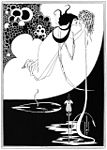
The Climax, illustration for Oscar Wilde's Salome; by Aubrey Vincent Beardsley; 1893; line block print; 34 × 27 cm; private collection[109]
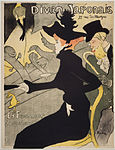
Divan Japonais; by Henri de Toulouse-Lautrec; c. 1893–1894; litograph; 81 × 62.3 cm; Museum of Fine Arts (Boston, USA)

Loie Fuller Dancing; by Pierre Roche; 1894 (bronze, 1901); Musée des Arts Décoratifs (Paris)

Gate of the Castel Béranger (an apartment building); by Hector Guimard; 1895–1898; Paris

Hôtel Solvay; by Victor Horta; 1895–1898; Brussels (Belgium)

Masque; by Louis Welden Hawkins; 1895–1905; black chalk and pencil on light brown paper; 43.2 × 23.8 cm; Museum of Fine Arts (Houston, USA)

Vase; by Émile Gallé; 1896; glass; height: 17.5 cm; Metropolitan Museum of Art (New York City)
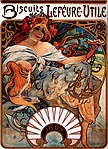
Biscuits Lefèvre-Utile, advertisement; by Alfons Mucha; 1897; lithograph; 62 × 43.5 cm; private collection

The Dragonfly brooch; by René Lalique; c. 1897–1898; gold, vitreous enamel, chrysoprase, chalcedony, moonstone and diamond; height: 23 cm, width: 26.5 cm; Calouste Gulbenkian Museum (Lisboa, Portugal)

Cabinet-vitrine; by Gustave Serrurier-Bovy; 1899; red narra wood, ash, copper, enamel and glass; height: 248.9 cm, width: 213.4 cm, depth: 63.5 cm; Metropolitan Museum of Art

Le Jeu de l'echarpe (Dancer with scarf); by Agathon Leonard; before 1901; gilt bronze; Hessisches Landesmuseum Darmstadt (Darmstadt, Germany)

Hair ornament; by René Lalique; c. 1902; gold, emeralds and diamonds; Musée d'Orsay (Paris)

The Casa Batlló; by Antoni Gaudí; Barcelona

Cabinet; Eugene Vallin in collaboration with Victor Prouvé; c. 1903–1906; probably made of mahogany; Musée de l'École de Nancy (Nancy, France)

Balcony with a relief under it, on the façade of the Hôtel Brion from Strasbourg (France), completed in 1904

The top of a tiled stove from the (Bucharest, Romania)
Fauvism (c. 1898–1908)[]

Fauvism emerged from post-impressionism, gradually developing into the first major movement of the 20th century. Its genesis was in 1895 when Henri Matisse, the oldest and central figure, entered the studio of Gustave Moreau at the Ecole des Beaux-Arts. There he met Georges Rouault, Charles Camoin, Henri Manguin, and Albert Marquet. Marquet said "As early as 1898 Matisse and I were working in what was later to be called the Fauve manner. The first exhibitions at the Indepéndants in which we were, I believe, the only ones to paint in pure tones, go back to 1901."[110] By 1902–03 the circle of like-minded artist had grown to include Georges Braque, André Derain, Raoul Dufy, Othon Friesz, Jean Metzinger, Jean Puy, Louis Valtat, Kees van Dongen, and Maurice de Vlaminck. During this period a number of influential retrospective exhibitions were held in Paris: Seurat (1900, 1905), Van Gogh (1901, 1905), Toulouse-Lautrec (1902), Gauguin (1906), Cézanne (1907), all relatively unknown to the public at that time. Matisse and Derain collected African carvings, a novel but growing curiosity of the time. Matisse spent the summer of 1904 in Saint-Tropez painting with the neo-impressionist Paul Signac and Henri-Edmond Cross, followed in1905 by Camoin, Manguin, and Marquet. The artist exhibited regularity at the Salon des Indepéndants and the Salon d'Automne 1903–1908 and in 1905 their work created a sensation and a scandal. Matisse stated "We were exhibiting at the Salon d'Automne, Derain, Manguin, Marquet, Puy, and a few others were hung together in one of the larger galleries. In the center of this room the sculptor Marque exhibited a bust of a child very much in the Italian style. Vauxcelles [art critic for Gil Blas] entered the room and said, Well! well! Donatello in the mist of wild beasts! [Donatello chez les fauves]."[111] The movement had not been perceived as an entity by the public, but once published the name stuck. Unlike the impressionist and their long struggle for acceptance, the avant-garde had an eager audience by 1906–1907 and the fauvist were attracting collectors from America to Russia. However fauvism largely dissolved in 1908, as cubism appeared, most of the artist began exploring other styles and moving in different directions. Only Matisse and Dufy continued to explore fauvism into the 1950s.[110]<[112][113][114][115]
The fauvist painted landscapes en plein air, interiors, figures, and still lifes, following examples of realism, impressionism, and post-impressionism. They applied paint with loose brushstrokes, in thick, unnatural, often contrasting, vibrant colors, at times straight from the tube. Gauguin's influence, with his exploration of the expressive values and spatial aspects of patterning with flat, pure colors, as well as his interest in primitivism were significant, as was neo-impressionism. Matisse explained – for a long time color served as a complement of design, the painters of the Renaissance constructed the picture by line, adding local color afterwards – writing: "From Delacroix to Van Gogh and chiefly to Gauguin, by way of the Impressionist, who cleared the ground, and Cézanne, who gave the final impulse and introduced colored volumes, we can follow this rehabilitation of color's function, this restoration of its emotive power"[110] Fauvism was the culmination in a shift, from drawing and line as the fundamental foundations of design in painting to color, and they depicted their subjects on the verge of abstraction.[110][112][113][114][115]
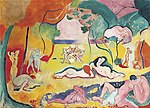
Le bonheur de vivre, by Henri Matisse; 1905–1906; oil on canvas; 175 × 241 cm; Barnes Foundation

Houses at Chatou; by Maurice de Vlaminck; ca. 1905; oil on canvas, 81 × 101 cm; Art Institute of Chicago

Fauve Landscape; by Louis Valtat; 1905–1906; oil on canvas; Speed Art Museum
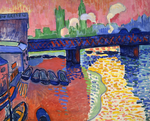
Charing Cross Bridge, London; by André Derain; 1906; oil on canvas, 80.3 × 100.3 cm.; National Gallery of Art
La Ciotat; by Othon Friesz; 1907; oil on canvas, 65.7 by 81 cm.; collection unknown
Expressionism (c. 1905–1933)[]

Expressionism was an international movement in painting, sculpture, the graphic arts, poetry, literature, theater, film, and architecture. Some associate the Second Viennese School and other music of the period with the movement. Most historians place the beginning of expressionism in 1905 with the founding of the Die Brücke. However, several artist were producing influential work that was in the spirit of expressionism c. 1885–1905 including Lovis Corinth, James Ensor, Käthe Kollwitz, Paula Modersohn-Becker, Edvard Munch, Emil Nolde, and Christian Rohlfs among others. Many of these artist later exhibited and associated with various expressionist groups. Expressionist painting is characterized by loose, spontaneous, frequently thick, impasto brushwork. It often conveyed how the artist felt about their subject, opposed to what it looked like, putting intuition and gut feelings over realistic representations or art theories. Expressionism was frequently infused with an angst or joy, and an overall engagement with contemporary life and social issues that was often absent from fauvism's focus on design and color applied to neutral subjects. Woodcut prints are particularly noteworthy in expressionism. Expressionism can sometimes overlap and integrate with other styles and movements, such as symbolism, fauvism, cubism, futurism, abstraction, and dada. Several groups and factions of expressionist appeared at various times and places.[78][101][78][116][117]
Die Brücke (The Bridge: 1905 -1913) aspired to connect "all revolutionary and surging elements."[116] It was founded by four architectural students Ernst Ludwig Kirchner, Erich Heckel, Karl Schmidt-Rottluff, and Fritz Bleyl. Sharing a studio in Dresden they produced paintings, carvings, prints, and organized exhibitions, separating in the summer to work independently. Their first exhibit was in 1905, later joined by Emil Nolde and Max Pechstein in 1906, and Otto Mueller in 1910 among others. Influences included Gothic art, primitivism, Art Nouveau, and developments in Paris, particularly Van Gogh and fauvism. The group shifted to Berlin in 1911 and later dissolved in 1913. Der Blaue Reiter (The Blue Rider: 1911–1914), founded by Wassily Kandinsky and Franz Marc, was a relatively informal group that organized exhibitions of art from Paris and Europe, as well their own. It was one in a series of increasingly progressive groups splitting from the Art Academy in Munich including The Munich Secession in 1892 (realist & impressionist), Phalanx in 1901 (postimpressionist), Neue Kunstler Vereiningung in 1909, and The Blue Rider in 1911. Artist associated with the latter two groups included the Burliuk brothers, Heinrich Campendonk, Alexej von Jawlensky, Paul Klee, August Macke, Gabriele Münter, and Marianne von Werefkin. The euphonious almanac Der Blaue Reiter, a collection of influential essays, and Kandinsky's Concerning the Spiritual in Art with his ideas on non-objective art were both published in 1912. The Blue Rider ended with the outbreak of World War I in which Macke and Marc both died.[78][101][118][116][117]
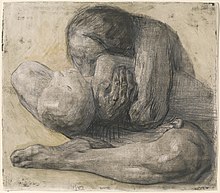
Other artists such as Oskar Kokoschka, Egon Schiele, and Richard Gerstl emerged in Austria. French artist Georges Rouault and Chaim Soutine had affinities with the movement. Sculptors include Ernst Barlach, Wilhelm Lehmbruck, Gerhard Marcks, and William Wauer. Architects associated with expressionism include Max Berg, Hermann Finsterlin, Johann Friedrich Höger, Michel de Klerk, Erich Mendelsohn, Hans Poelzig, Hans Scharoun, Rudolf Steiner, and Bruno Taut. Der Sturm (The Storm 1910–1932) was a magazine with much expressionist content founded by Herwarth Walden, with an associated gallery in Berlin opened in 1912 and a theater company and school in opened 1918. Films regarded as expressionistic, some considered as classics, include The Cabinet of Dr. Caligari (Robert Wiene, 1920), Nosferatu (F. W. Murnau,1922), and Metropolis (Fritz Lang, 1927).[78][101][118][116][117]
After World War I a tendency to withdraw from the avant-garde by many artist occurred, seen in the work of the original fauvists during the 1920s, Picasso and Stravinsky's neoclassical periods, and De Chirico's late work. This tendency was called New Objectivity (ca. 1919–1933) in Germany, and in contrast to the nostalgic nature of this work elsewhere, it was characterized by disillusionment and ruthless social criticisms. New objectivity artists mostly emerged from expressionist and dada milieus including Otto Dix, Christian Schad, Rudolf Schlichter, Georg Scholz, and Jeanne Mammen. Max Beckmann and George Grosz also had some association with new objectivity for a period. Although not intrinsically expressionistic, the Staatliches Bauhaus (School of Building: 1919–1933) was an influential German school merging crafts, decorative, and fine arts. Moving from Weimar, to Dessau, to Berlin, it changed and evolved in focus with time. Directors included architects Walter Gropius (1919–1928), Hannes Meyer (1928–1930), and Ludwig Mies van der Rohe (1930–1933). At various points the faculty included Josef Albers, Theo van Doesburg, Lyonel Feininger, Johannes Itten, Paul Klee, Wassily Kandinsky, El Lissitzky, Gerhard Marcks, László Moholy-Nagy, Oskar Schlemmer. Bauhaus architects greatly influenced the International Style, which was characterized by simplified forms, a lack of ornamentation, a union of design and function, and the idea that mass production could be compatible with personal artistic vision. As the Nazi Party rose to power, modern art was dubbed "degenerate art" and the Bauhaus was closed in 1933, subduing modernism in Germany for several years.[78][101][118][116][117]

Skeletons Fighting for the Body of a Hanged Man; by James Ensor; 1891; oil on canvas; 59 × 74 cm; Royal Museum of Fine Arts Antwerp

In the Slaughterhouse; by Lovis Corinth; 1893; oil on canvas, 78 × 89 cm.; Staatsgalerie Stuttgart

The Scream; by Edvard Munch; 1893; oil, tempera and pastel on cardboard, 91 × 73 cm; National Gallery of Norway

The Cossacks; by Wassily Kandinsky; 1910–11; oil on canvas, 94 × 130 cm.; Tate Modern

The Yellow Cow; by Franz Marc; 1911; oil on canvas, 140.5 × 189.2 cm.; Solomon R. Guggenheim Museum

The Avenger; by Ernst Barlach; 1914; bronze, 58.4 cm. width; National Gallery of Art

Self-portrait as a Soldier; by Ernst Ludwig Kirchner; 1915, 69.2 × 60.9 cm.; Allen Memorial Art Museum

Death and the Maiden; by Egon Schiele; 1915; oil on canvas, 150 × 180 cm; Österreichische Galerie Belvedere

The Fallen; by Wilhelm Lehmbruck; 1915–16; plaster 29.5 × 94.5; Wilhelm Lehmbruck Museum, Duisburg

The Night; by Max Beckmann; 1918–19; oil on canvas, 133 × 154 cm, Kunstsammlung Nordrhein-Westfalen

Still Life with Rayfish; by Chaim Soutine; ca. 1924; oil on canvas, 81.3 × 100 cm.; Metropolitan Museum of Art

Grosses Schauspielhaus (Grand Theatre); by Hans Poelzig; 1919; Berlin, Germany

Einstein Tower; by Erich Mendelsohn; 1920. Potsdam, Germany
Cabinet of Dr. Caligari; by Atelier Ledl Bernhard; 1920; promotional poster for the film directed by Robert Wiene
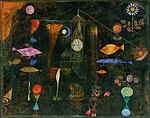
Fish Magic; by Paul Klee; 1925; oil & watercolor on canvas on panel, 77 × 98 cm.; Philadelphia Museum of Art
Cubism[]
Cubism consisted in the rejection of perspective, which leads to a new organisation of space where viewpoints multiply producing a fragmentation of the object that renders the predilection for form over the content of the representation obvious. Pablo Picasso, Georges Braque and other Cubist artists were inspired by the sculptures of Iberia, Africa and Oceania exhibited in the Louvre and the ethnographic museum in the Trocadéro, and which were being offered at flee markets and in sale rooms.
'A Picasso studies an object the way a surgeon dissects a corpse,' wrote the critic and poet Guillaume Apollinaire in 1913. Five years earlier, Pablo Picasso and Georges Braque – friends, colleagues and rivals – had begun to reject perspectival realism for a form of artistic autopsy: an utterly revolutionary painting style that looked inside and around objects, presenting them analytically, objectively and completely impersonally.[119]

Les Demoiselles d'Avignon; by Pablo Picasso; 1907; oil on canvas; 244 × 234 cm; Museum of Modern Art

Houses at l'Estaque; by Georges Braque; 1908; oil on canvas; 73 × 59.5 cm; Lille Métropole Museum of Modern, Contemporary and Outsider Art

Glass of Beer and Playing Cards; by Juan Gris; 1913; oil and collage on canvas; 52.5 × 36.5 cm; Columbus Museum of Art

Unique Forms of Continuity in Space; by Umberto Boccioni; 1913; bronze; height: 1.09 m; Museum of Modern Art
Surrealism (c. 1924–1950)[]

Surrealism emerged as a faction of Dada, formally announcing its inception in 1924 with André Breton's Manifesto of Surrealism.[120] Originally a literary group of poets and writers in Paris, it soon developed into an international movement that included painters, sculptors, photographers, and filmmakers. A Second Manifeste du Surréalisme was published in 1929.[121] Surrealism did not have significant expression in applied or decorative arts, architecture, or music, although a few isolated examples could be identified (e.g. chess sets, furniture, and Las Pozas). The small and short lived Metaphysical School (c. 1910–1921), with Giorgio de Chirico as its principal figure, was highly influential on surrealism. The surrealist explored a myriad of innovative techniques, some had recently been developed in Cubism and Dada, others were new, including collage, found objects, assemblage, random chance, rayographs (photograms), painting on sand, dripping and flinging paint, decalcomania, frottage, fumage, and raclage. Two fundamental approaches predominate surrealist art. Automatism dominated in the early years which can be seen in the work of artist like André Masson and Joan Miró. Other artist, swayed by work of Giorgio de Chirico, used more traditional methods and mediums to illustrate unfiltered thoughts and incongruous juxtapositions, including Salvador Dali and René Magritte. Significant artist include Jean Arp, Hans Bellmer, Victor Brauner, Luis Buñuel, Joseph Cornell, Óscar Domínguez, Max Ernst, Wifredo Lam, Yves Tanguy, Man Ray, Alberto Giacometti, Méret Oppenheim, and Roberto Matta. Other important artist informally accosted with surrealism include Marcel Duchamp, Pablo Picasso, and Frida Kahlo. Surrealist ideas and theories were discussed in a successive series of journals, La Révolution Surréaliste (1924–1929), Le Surrealisme au service de la revolution (1930–1933), Minotaure (1933–1939), VVV (1942–1944). The automatic paintings produced by André Masson and Joan Miró, as well as latecomers to surrealism like Roberto Matta and Arshile Gorky had a considerable influenced on the abstract expressionist in the late 1940s.[122][123][124][125][126][127]
With a measure of Dada's irreverence and contempt for the traditional political, religious, and bourgeois values of western culture that they believed had led the world into the First World War (Breton and other founding members were veterans); the surrealist explored the possibilities that had been opened up by Sigmund Freud regarding the subconscious mind: "Pure psychic automatism, by which one intends to express verbally, in writing or by any other method, the real functioning of the mind. Dictation by thought, in the absence of any control exercised by reason, and beyond any aesthetic or moral preoccupation."[120] Surrealism sought to express pure thought, unfiltered and uncensored by political, religious, moral, or rational principles.[122][123][124][125][126][127]

The Seer; by Giorgio de Chirico; 1914–15; oil on canvas; 89.6 × 70.1 cm; Museum of Modern Art

Time Transfixed; by René Magritte; 1938; oil on canvas; 147 × 98.7 cm.; Art Institute of Chicago

Signe (Le vent), by Victor Brauner; 1942; white marble; 31 cm; Cimetière de Montmartre (Paris)
Mid-20th century[]
Pop Art[]
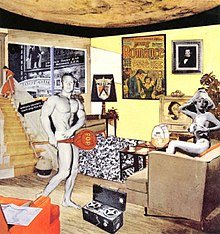
The term 'Pop' first appeared in print in an article by English critic Lawrence Alloway in 1958, but the new interest in popular culture, and the attempt to make art out of it, was a feature of the Independent Group in London from the early 1950s. Richard Hamilton, Eduardo Paolozzi and other discussed the growing mass culture of movies, advertising, science fiction, consumerism, media and communications, product design and new technologies originating in America, but now spreading through the west. They were particularly fascinated by advertising, and graphic, and product design, and wanted to make art and architecture that had a similarly seductive appeal. Hamilton's collage Just what is it that makes today's homes so different, so appealing? (1956), made from American magazine advertisements, was the first work to achieve iconic status. The next generation of students in London, including Patrick Caulfield and David Hockney, also incorporated popular culture into their collages and assemblages, and in the period between 1959 and 1962 achieved public notoriety.
In the early 1960s, in the United States themselves, the public saw for the first time the works that since have become famous: Andy Warhol's Marilyn Monroe, Roy Lichtenstein's comic-strip oils, Claes Oldenberg's gigantiv vinyl burgers and ice cream cones, and Tom Wesselmann's nudes set in domestic settings that incorporate real shower curtains, telephones and bathroom cabinets. Public attention culminated in a large international exhibition mounted at the Sidney Janis Gallery in New York in 1962. Works by British, French, Italian, Swedish and American artists were grouped around the themes of the 'daily object', 'mass media', and the 'repetition' or 'accumulation' of mass-produced objects. It was a defining moment. Sidney Janis was the leading dealer in blue-chip European moderns and Abstract Expressionists, and his exhibition consecrated the work as the next art historical movement to be discussed and collected.[128]
I Saw the Figure 5 in Gold; by Charles Demuth; 1928; 90.2 × 76.2 cm; Metropolitan Museum of Art
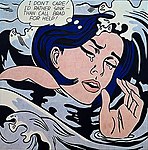
Drowning Girl; by Roy Lichtenstein; 1963; oil and synthetic polymer paint on canvas; 171.6 × 169.5 cm; Museum of Modern Art
Late 20th and early 21st centuries[]

Rapid advances in science and technology led to the late Modern and Postmodern period. In these periods, the art and cultures of the world went through many changes, and there was a great deal of intermixture between cultures, as new communications technologies facilitated the national and even global dissemination of music, art and style. The separation of regional cultures that had marked the 19th century was replaced by a global culture. Postmodernism describes a broad movement that developed in the mid- to late-20th century across philosophy, the arts, architecture, and criticism which marked a departure from modernism.[130][131][132] One contemporary view of Postmodern art shows that it can be understood as an expansion of technology-based media enabling multiple new forms of art simultaneously.[133] The transition from linear art movements of the early 20th century modern era to multiple simultaneous movements of the last 20th century Postmodern is shown in a Timeline of 20th.C Art and New Media.[134] Art movements specific of the late 20th and early 21st centuries include land art, video art, photorealism, hyperrealism, and digital art.
Dona i Ocell; by Joan Miró; 1983; Parc Joan Miró

Pencils; by Guerrino Boatto; 1 August 1986; acrylic on scholler; 70 × 50 cm; private collection

Rose; by Isa Genzken; 1993; in front of Neue Leipziger Messe (Leipzig, Germany)

L'Ange Protecteur; by Niki de Saint Phalle; inception in 1997; Zürich Hauptbahnhof

Maman; by Louise Bourgeois; bronze and glass; inception late 1990s; Guggenheim

Chinese guardian lion; by ; 2014; ice; Stockholm International Film Festival 2014
Parallel to this development, the interface between the media, which were largely separate at that time, in the narrow understanding of the concept of art, between painting and photography became art-historically relevant through the work of the photo artists Pierre Cordier () in the early nineteen-seventies, Paolo Monti (chemigram) and Josef H. Neumann (chemogram) in the new Visuel Arts. In 1974, Josef H. Neumann's chemogram closed the separation of the painterly ground and the photographic layer, in that, in a symbiosis that was unprecedented up to that point in time, they were unmistakably unique in a simultaneous painterly and real photographic perspective within a photographic layer in colors and Forms united. [135]
- Chemogramme and Chimigramme
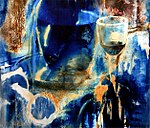
Josef H. Neumann: Chemogramm,Gustav I (1976)

Paolo Monti: Chimigramm, Serie fotografica, 1970
See also[]
- Art of Europe
- Art market
- Art movement
- Art periods
- Ancient art
- History of animation
- History of Asian art
- History of film
- History of literature
- History of music
- History of painting
- History of photography
- History of theatre
- List of art movements
- List of French artistic movements
- List of music styles
- Timeline for invention in the arts
- Timeline of art
- Western art history
- Women artists
Notes[]
- ^ Joordens et al. 2015, pp. 228–231.
- ^ Hodge, Susie (2017). The Short Story of Art. Laurence King Publishing. p. 12. ISBN 978-1-78067-968-6.
- ^ Fortenberry 2017, p. 1 & 2.
- ^ Fortenberry 2017, p. 2.
- ^ Jump up to: a b Fortenberry 2017, p. 3.
- ^ Hodge, Susie (2017). The Short Story of Art. Laurence King Publishing. p. 12. ISBN 978-1-78067-968-6.
- ^ Fortenberry 2017, p. 7.
- ^ Jump up to: a b Fortenberry 2017, p. 4.
- ^ Azcárate 1983, pp. 36–44.
- ^ Fortenberry 2017, p. 6.
- ^ Azcárate 1983, pp. 29–34.
- ^ Fortenberry 2017, p. 15.
- ^ Fortenberry 2017, p. 19.
- ^ Jump up to: a b Fortenberry 2017, p. 16.
- ^ Jump up to: a b c d Fortenberry 2017, p. 209.
- ^ Fortenberry 2017, p. 25.
- ^ Fortenberry 2017, p. 30.
- ^ Fortenberry 2017, p. 36.
- ^ Mattinson 2019, p. 21.
- ^ Toynbee 1971, pp. 439–442.
- ^ Hitti 2002, p. ?.
- ^ Leidy, Denise Patry (14 September 2012). "Evolution of Chinese Ceramics and Their Global Influence are Theme of Entirely New Installation on Metropolitan Museum's Great Hall Balcony". Metropolitan Museum of Art. Archived from the original on 23 September 2018. Retrieved 29 September 2018.
- ^ Benson 1996, p. 263.
- ^ 32,000 YEARS OF ART. Phaidob. 2007. p. 142. ISBN 978-0-7148-7729-7.
- ^ Grann 2009, p. 315.
- ^ "History – Winnipeg Art Gallery". Archived from the original on 2018-11-11. Retrieved 2018-11-17.
- ^ "Museum of Inuit Art". Archived from the original on 2018-04-22. Retrieved 2020-01-15.
- ^ "'Small but mighty' Canadian Museum of Inuit Art closing its doors". Archived from the original on 2018-06-04. Retrieved 2018-11-17.
- ^ "Carvings Nunavut". Archived from the original on 2018-11-11. Retrieved 2018-11-17.
- ^ Fortenberry 2017, p. 66.
- ^ Jump up to: a b c Fortenberry 2017, p. ?.
- ^ Fortenberry 2017, p. 68.
- ^ Keiko 2010, pp. 57–63.
- ^ Harle 1994, pp. 26–47, 105–117.
- ^ Harle 1994, pp. 59–70.
- ^ "Pala India, Maitreya – standing". Himalayanbuddhistart. WordPress.com. October 16, 2016. Archived from the original on 26 August 2018. Retrieved 29 September 2018.
- ^ Fischer 2006, p. ?.
- ^ Brunt et al. 2018, p. 104.
- ^ Jump up to: a b Brunt et al. 2018, p. 299.
- ^ Cavarnos & Michelis 1956, p. 506.
- ^ Weitzmann 1981, p. ?.
- ^ Kitzinger 1977, pp. 1‒3.
- ^ Fortenberry 2017, p. 115.
- ^ Tani & Murphy 2006, pp. 81–95.
- ^ Caviness 2001, p. 106.
- ^ Koslin 1990, pp. 28–29.
- ^ Musset & Bertrand 1966, p. 23.
- ^ Fortenberry 2017, p. 149.
- ^ Graur 1970, pp. 52–53.
- ^ Fortenberry 2017, p. 151.
- ^ Fortenberry 2017, p. 152.
- ^ Fortenberry 2017, p. 156.
- ^ Fortenberry 2017, p. 243.
- ^ Graur 1970, p. 153.
- ^ Graur 1970, p. 168.
- ^ "Pier Table". Art Institute of Chicago. Archived from the original on 2020-08-22. Retrieved 2021-03-20.
- ^ Jump up to: a b Fortenberry 2017, p. 267.
- ^ Bailey 2012, p. 272.
- ^ Jump up to: a b Fortenberry 2017, p. 265.
- ^ Mattinson 2019, p. 95.
- ^ Graur 1970, p. 160.
- ^ Peter Delius, Verlag (2017). Arta — o istorie ilustrată — (in Romanian). Litera. p. 274.
- ^ Bailey 2012, pp. 279, 281.
- ^ Marnie, Fogg (2013). Fashion: The Whole Story (in Romanian). Thames & Hudson. p. 111 & 112. ISBN 9780500291108.
- ^ Fortenberry 2017, p. 273.
- ^ Graur 1970, pp. 223–224.
- ^ Arnason 1977, p. 740.
- ^ Janson 1977, p. 767.
- ^ Starobinski 1964.
- ^ Keyser 1965, p. ?.
- ^ Jump up to: a b c d Ponente 1965, p. ?.
- ^ Jump up to: a b c Toman 2000, p. ?.
- ^ Daval 1979, p. 221.
- ^ Jump up to: a b c d Janson 1977, p. ?.
- ^ Jump up to: a b Bris 1981, p. ?.
- ^ Clay 1981, p. ?.
- ^ Claudon 1980, p. ?.
- ^ Jump up to: a b c d e f g h Arnason 1977, p. ?.
- ^ Leymarie 1962, p. ?.
- ^ Jump up to: a b c Blunden 1976, p. ?.
- ^ Jump up to: a b Clay 1973, p. ?.
- ^ Faunce 1993, p. ?.
- ^ Jump up to: a b Courthion 1979, p. ?.
- ^ Jump up to: a b Leymarie 1955, p. ?.
- ^ Jump up to: a b c Delevoy 1978, p. ?.
- ^ Jump up to: a b c Cassou 1979, p. ?.
- ^ Morris, Roderick Conway (2007-03-16). "The elusive Symbolist movement". The New York Times. Archived from the original on 2021-04-30. Retrieved 2021-04-30.
- ^ Pevsner 2005, p. ?.
- ^ Barucka 2010, pp. 83, 86.
- ^ Raynal 1954, p. ?.
- ^ Schapiro 1962, p. ?.
- ^ Estienne 1953a, p. ?.
- ^ Goldwater 1972, p. ?.
- ^ Courthion 1988, p. ?.
- ^ Alexandrian 1980, p. ?.
- ^ Estienne 1953b, p. ?.
- ^ Schapiro 1950, p. ?.
- ^ Lassaigne 1950, p. ?.
- ^ Cooper 1966, p. ?.
- ^ Jump up to: a b Raynal 1953, p. ?.
- ^ Jump up to: a b c d e f Daval 1979, p. ?.
- ^ Preston 1974, p. ?.
- ^ Warnod 1989, p. ?.
- ^ Terrasse 1964, p. ?.
- ^ Fermigier 1969, p. ?.
- ^ De la Bédoyère 2017, pp. 16–17.
- ^ Jump up to: a b Bouillon 1985, p. ?.
- ^ Jump up to: a b Fahr-Becker 1997, p. ?.
- ^ Andrew 2018, p. 387.
- ^ Jump up to: a b c d Leymarie 1959, p. ?.
- ^ Clay 1978.
- ^ Jump up to: a b Clay 1978, p. ?.
- ^ Jump up to: a b Diehl, Gaston (1972) The Fauves: Library of Great Art Movements. Harry N. Abrams, Inc., Publishers, New York. 168 pp. ISBN 0-8109-0114-5
- ^ Jump up to: a b Lassaigne 1959, p. ?.
- ^ Jump up to: a b Jacobus, J. (1973) Matisse: Library of Great Painters. Harry N. Abrams, Inc., Publishers, New York, 184 pp.
- ^ Jump up to: a b c d e Dube 1983, p. ?.
- ^ Jump up to: a b c d Richard 1978, p. ?.
- ^ Jump up to: a b c Daval 1980, p. ?.
- ^ Fortenberry 2017, p. 330.
- ^ Jump up to: a b Breton 1924, p. ?.
- ^ Breton 1929, p. ?.
- ^ Jump up to: a b Waldberg 1962, p. ?.
- ^ Jump up to: a b Rubin 1968, p. ?.
- ^ Jump up to: a b Schneede 1974, p. ?.
- ^ Jump up to: a b Passeron 1975, p. ?.
- ^ Jump up to: a b Picon 1977, p. ?.
- ^ Jump up to: a b Jean 1980, p. ?.
- ^ Dempsey 2018, pp. 116–117.
- ^ Fortenberry 2017, p. 386.
- ^ "Postmodernism". Oxford Dictionaries. Oxford University Press. Archived from the original on 4 May 2016. Retrieved 29 September 2018.
- ^ Reichl, Ruth (1989). "postmodern". American Heritage Dictionary (4th ed.). Houghton Mifflin. Archived from the original on 9 December 2008. Retrieved 29 September 2018.
- ^ Mura 2012, pp. 68–87.
- ^ Hoetzlein, Rama (2009). "What is New Media Art?". Archived from the original on 2018-12-06. Retrieved 2018-12-06.
- ^ Hoetzlein, Rama (2009). "Timeline of 20th C. Art and New Media". Archived from the original on 2018-12-06. Retrieved 2018-12-06.
- ^ Hannes Schmidt: Remarks to the Chemograms from Josef H. Neumann. Exhibition in photography Studio Galerie from Prof. Pan Walther. In: Photo-Presse. Issue 22, 1976, S. 6.
References[]
- Alexander, Robert L. (1986). The Sculpture and Sculptors of Yazılıkaya. Newark: University of Delaware Press. ISBN 0-87413-279-7. Archived from the original on 2021-04-23. Retrieved 2021-04-23.
- Alexandrian, Sarane (1980). Seurat. New York: Crown. ISBN 0-517-54106-8.
- Andrew, Graham-Dixon (2018). Art : the definitive visual guide. London. ISBN 978-0-241-25710-4.
- Arnason, H. H. (1977). History of Modern Art: Painting, Sculpture, Architecture (2d ed., rev. and enl. ed.). Englewood Cliffs, N.J.: Prentice-Hall. ISBN 0-13-390351-6. Archived from the original on 2021-04-30. Retrieved 2021-04-30.
- Azcárate, José María de (1983). Historia del arte (in Spanish). Madrid: Anaya. ISBN 84-207-1408-9.
- Bailey, Gauvin Alexander (2012). Baroque & Rococo. Phaidon. ISBN 978-0-7148-5742-8.
- Barucka, Edyta (2010). "Redefining Polishness : The Revival of Crafts in Galicia around 1900". Acta Slavica Iaponica. 28: 71–99. ISSN 0288-3503. Archived from the original on 2021-04-30. Retrieved 2021-04-30.
- Bar-Yosef, Ofer (2016). "The Archaeological Framework of the Upper Paleolithic Revolution". Diogenes. 54 (2): 3–18. doi:10.1177/0392192107076869. ISSN 0392-1921. S2CID 145584993.
- Belfer-Cohen, Anna; Bar-Yosef, Ofer (1981). "The Aurignacian at Hayonim Cave". Paléorient. 7 (2): 19–42. doi:10.3406/paleo.1981.4296. Archived from the original on 2019-05-05. Retrieved 2019-05-05.
- Benson, Elizabeth P. (1996). "110. Votive Axe". In Elizabeth P. Benson; Beatriz de la Fuente (eds.). Olmec Art of Ancient Mexico (To accompany an exhibition at the National Gallery of Art, Washington, 30 June to 20 October 1996 ed.). Washington, D.C.: National Gallery of Art. ISBN 0-89468-250-4.
- Blundell, Geoffrey (2006). Origins: The Story of the Emergence of Humans and Humanity in Africa. Juta and Company Ltd. ISBN 9781770130401. Archived from the original on 2020-01-24. Retrieved 2019-05-11.
- Blunden, Maria (1976). Impressionists and impressionism. Geneva: Skira. ISBN 0-8478-0047-4.
- Branan, Nicole (2010). "Neandertal Symbolism: Evidence Suggests a Biological Basis for Symbolic Thought". Scientific American Mind. 21 (2). doi:10.1038/scientificamericanmind0510-7c. ISSN 1555-2284. Archived from the original on 2018-06-14. Retrieved 2019-05-13.
- Bris, Michel Le (1981). Romantics and Romanticism by Michel Le Bris. MacMillan. Archived from the original on 2021-04-30. Retrieved 2021-04-30.
- Boardman, John; Johnston, Alan; Smith, R. R. R.; Pollitt, Jerome Jordan; Huskinson, Janet (1993). The Oxford History of Classical Art. Oxford: Oxford University Press. ISBN 0-19-814386-9. Archived from the original on 2021-09-13. Retrieved 2019-08-20.
- Bouillon, Jean-Paul (1985). Journal de l'art nouveau : 1870-1914 [Journal of Art Nouveau: 1870-1914]. Genèva: Skira. ISBN 2-605-00069-9. Archived from the original on 2021-04-30. Retrieved 2021-04-30.
- Breton, André (1929-12-15) [1930]. Kra, Simon (ed.). "Second Manifeste du Surréalisme" [Second manifesto of surrealism] (PDF). La Révolution surréaliste (in French). Paris: Éditions Kra. 2 (12). Archived (PDF) from the original on 2021-03-08. Retrieved 2021-04-30.
- Breton, André (1924), Manifeste du Surrealism: Poissòn Soluble [Manifesto of Surrealism: Poissòn Soluble] (in French), 1st, Paris: Aux du Sagittaire, archived from the original on 2021-04-27, retrieved 2021-04-30
- Brunt, Peter William; Thomas, Nicholas; Salmond, Anne; Kasarherou, Emmanuel; Mel, Michael A. (2018). Oceania. Royal Academy of Arts. ISBN 978-1-910350-49-2. Archived from the original on 2021-04-30. Retrieved 2021-04-30.
- Cassou, Jean (1979). The concise encyclopedia of symbolism. Secaucus, N.J.: Chartwell Books. ISBN 0-89009-706-2.
- Caubet, Annie (2019). Idols The Power of Images. Rizzoli International Publications. ISBN 978-88-572-3885-2.
- Cavarnos, Constantine; Michelis, P. A. (1956) [1946]. "An Aesthetic Approach to Byzantine Art". The Journal of Aesthetics and Art Criticism. 14 (4). doi:10.2307/426006. JSTOR 426006. Archived from the original on 2021-04-23. Retrieved 2021-04-23.
- Caviness, Madeline Harrison (2001). Reframing Medieval Art: Difference, Margins, Boundaries. Medford, MA: Tufts University. Archived from the original on 2021-04-30. Retrieved 2021-04-30.
- Claudon, Francis (1980). The Concise Encyclopedia of Romanticism. Secaucus, N.J.: Chartwell Books. ISBN 0-89009-707-0.
- Clay, Jean (1973). Impressionism. Secaucus: Chartwell Books Inc. ISBN 0-399-11039-9.
- Clay, Jean, ed. (1978). From Impressionism to Modern Art 1890–1918. Secaucus, New Jersey: Chartwell Books Inc. ISBN 0-89009-544-2.
- Clay, Jean (1981). Romanticism. New Jersey: Chartwell Books, Inc. Secaucus.
- Coe, Michael D. (2002). Mexico : from the Olmecs to the Aztecs (5th ed., rev. and expanded ed.). New York: Thames & Hudson. ISBN 0-500-28346-X.
- Cooper, Douglas (1966). Henri de Toulouse-Lautrec. New York: H.N. Abrams. ISBN 0-8109-0512-4. Archived from the original on 2021-04-30. Retrieved 2021-04-30.
- Cotterell, Arthur (1993). The Penguin Encyclopedia of Classical Civilizations (1st ed.). London: Viking. ISBN 0-670-82699-5.
- Courthion, Pierre (1979). Impressionism. New York: H.N. Abrams. ISBN 0-8109-0202-8.
- Courthion, Pierre (1988). Georges Seurat. New York: H.N. Abrams. ISBN 0-8109-1519-7. Archived from the original on 2021-04-30. Retrieved 2021-04-30.
- Dani, Ahmad Hasan; Masson, Vadim Mikhaĭlovich (1993). History of Civilizations of Central Asia: The Dawn of Civilization : Earliest Times to 700 B.C. 1. Paris: UNESCO. ISBN 978-92-3-102719-2. Archived from the original on 2021-04-23. Retrieved 2021-04-23.
- Daval, Jean Luc (1979). Modern art: The decisive years 1884-1914 (in French). Translated by Harrison, Helga. Geneva: Skira. ISBN 0-8478-0212-4. Archived from the original on 2021-04-30. Retrieved 2021-04-30.
- Daval, Jean-Luc (1980). Avant-garde art, 1914-1939. Geneva: Skira. ISBN 0-8478-0334-1. Archived from the original on 2021-04-30. Retrieved 2021-04-30.
- De la Bédoyère, Camilla (2017). Art nouveau. London. ISBN 978-1-78664-470-1.
- Delevoy, Robert L. (1978). Symbolists and Symbolism. New York: Skira. ISBN 0-8478-0141-1.
- Dempsey, Amy (2018). Modern Art. Thames & Hudson. ISBN 978-0-500-29322-5.
- Dissanayake, Ellen (1974). "A Hypothesis of the Evolution of Art from Play". Leonardo. 7 (3): 211–217. doi:10.2307/1572893. ISSN 0024-094X. JSTOR 1572893. S2CID 49569697.
- Drimba, Ovidiu (1985). Istoria Culturii și Civilizației [History of Culture and Civilization]. București. ISBN 973-44-0118-1. OCLC 20934624. Archived from the original on 2021-09-13. Retrieved 2021-04-23.
- Dube, Wolf Dieter (1983). Expressionists and expressionism. Geneva: Skira. ISBN 978-0-8478-0494-8. Archived from the original on 2021-04-30. Retrieved 2021-04-30.
- Estienne, Charles (1953a). Gauguin: Biographical and Critical Studies: The Taste of Our Time. 1. Skira. Archived from the original on 2021-04-30. Retrieved 2021-04-30.
- Estienne, Charles (1953b). Van Gogh: Critical Study: The Taste of Our Time (in French). 2. Geneva: Skira. Archived from the original on 2021-04-30. Retrieved 2021-04-30.
- Fahr-Becker, Gabriele (1997). Art nouveau. Cologne: Könemann. ISBN 3-89508-444-1.
- Faunce, Sarah (1993). Gustave Courbet. New York: H.N. Abrams. ISBN 0-8109-3182-6.
- Fermigier, André (1969). Pierre Bonnard: The Library of Great Painters (1st ed.). New York: Harry N. Abrams. ISBN 0-8109-0041-6.
- Fischer, Steven R. (2006). Island at the end of the world : the turbulent history of Easter Island. London: Reaktion. ISBN 1-86189-282-9.
- Fortenberry, Diane (2017). The Art Museum (Revised ed.). London: Phaidon Press. ISBN 978-0-7148-7502-6. Archived from the original on 2021-04-23. Retrieved 2021-04-23.
- Gardner, Helen; Kleiner, Fred S. (2009). Gardner's Art through the Ages: A Global History (13th ed.). Australia: Thomson/Wadsworth.
- Goldwater, Robert (1972). Paul Gauguin: The Library of Great Painters. Harry N. Abrams. Archived from the original on 2021-04-30. Retrieved 2021-04-30.
- Grann, David (2009). The Lost City of Z: A Tale of Deadly Obsession in the Amazon (1st ed.). New York: Doubleday. ISBN 978-0-385-51353-1. OCLC 226038067.
- Graur, Neaga (1970). Stiluri în arta decorativă (in Romanian). Cerces.
- Haidle, M.N. (2014). "Examining the evolution of artistic capacities: searching for mushrooms?". In Sütterlin, Christa; Schiefenhövel, Wulf; Lehmann, Christian; Forster, Johanna; Apfelauer, Gerhard (eds.). Art as behaviour. An ethological approach to visual and verbal art, music and architecture. Oldenburg: Bis-Verlag der Carl von Ossietzky Universität Oldenburg. pp. 237–251. Archived from the original on 2021-09-13. Retrieved 2021-02-22.
- Harle, J. C. (1994). The art and architecture of the Indian subcontinent (2nd ed.). New Haven: Yale University Press. ISBN 0-300-06217-6.
- Hitti, Philip K. (2002). History of The Arabs (10th ed.). Basingstoke: Palgrave Macmillan. ISBN 978-1-137-03982-8. Archived from the original on 2021-04-30. Retrieved 2021-04-30.
- Honour, Hugh; Fleming, John (2002). A World History of Art (Fifth ed.). London: Laurence King. ISBN 978-1-85669-314-1. Archived from the original on 2021-04-23. Retrieved 2021-04-23.
- Honour, H.; Fleming, J. (2005). A World History of Art. Laurence King. ISBN 978-1-85669-451-3. Archived from the original on 2021-09-13. Retrieved 2020-09-04.
- Janson, Anthony F. (1977). History of art, second edition, H.W. Janson. Instructor's manual. Englewood Cliffs, N.J.: Prentice-Hall. ISBN 0-13-389304-9. OCLC 17656707. Archived from the original on 2021-09-13. Retrieved 2021-04-30.
- Jean, Marcel (1980). The Autobiography of Surrealism. New York: Viking Press. ISBN 0-670-14235-2.
- Joordens, Josephine C. A.; d'Errico, Francesco; Wesselingh, Frank P.; Munro, Stephen; de Vos, John; Wallinga, Jakob; Ankjærgaard, Christina; Reimann, Tony; Wijbrans, Jan R.; Kuiper, Klaudia F.; Mücher, Herman J. (2015). "Homo erectus at Trinil on Java used shells for tool production and engraving". Nature. 518 (7538): 228–231. Bibcode:2015Natur.518..228J. doi:10.1038/nature13962. ISSN 1476-4687. PMID 25470048. S2CID 4461751. Archived from the original on 2021-03-02. Retrieved 2021-04-17.
- Keay, John (2000). India: A History (1st ed.). New York: Grove Press. ISBN 0-87113-800-X. Archived from the original on 2021-04-23. Retrieved 2021-04-23.
- Keiko, Yamada (2010). Origin and Historical Evolution of the Identity of Modern Telugus. Economic and Political Weekly.
- Keyser, Eugénie de (1965). The Romantic West, 1789-1850. World Publishing Company, Cleveland. ISBN 978-0-320-06349-7. Archived from the original on 2021-04-30. Retrieved 2021-04-30.
- Kitzinger, Ernst (1977). Byzantine Art in the Making: Main Lines of Stylistic Development in Mediterranean Art, 3rd‒7th Century. Cambridge: Cambridge University Press. ISBN 978-0571111541.
- Kohl, Philip L. (2007). The Making of Bronze Age Eurasia. Cambridge: Cambridge University Press. ISBN 978-0-511-27004-8.
- Koslin, Desirée (1990). "Turning Time in the Bayeux Embroidery". Textile & Text. 13.
- Laing, Lloyd Robert (2001). The Picts and the Scots (Rev. pbk. ed.). Stroud: Sutton Pub. ISBN 0-7509-2873-5. Archived from the original on 2021-04-23. Retrieved 2021-04-23.
- Lamberg-Karlovsky, C. C. (2002). "Archaeology and Language: The Indo-Iranians". Current Anthropology. 43 (1). doi:10.1086/324130. ISSN 0011-3204. S2CID 162536112. Archived from the original on 2021-04-30. Retrieved 2021-04-30.
- Lassaigne, James (1950). Lautrec: Biographical and Critical Studies, The Taste of Our Time. 3. Skira. Archived from the original on 2021-04-30. Retrieved 2021-04-30.
- Lassaigne, Jacques (1959). Matisse: Biographical and Critical Study. Skira. Archived from the original on 2021-04-30. Retrieved 2021-04-30.
- Leymarie, Jean (1955). Impressionism, Vols. 11 & 12: The Taste of Our Time. 11–12. Geneva: Skira.
- Leymarie, Jean (1959). Fauvism: Biographical and Critical Study. Translated by James Emmons. 28. Geneva: Skira. Archived from the original on 2021-04-30. Retrieved 2021-04-30.
- Leymarie, Jean (1962). French Painting: The Nineteenth Century. Geneva: Skira. Archived from the original on 2021-04-30. Retrieved 2021-04-30.
- Lipiński, Edward; Lerberghe, Karel van (1995). Immigration and Emigration Within the Ancient Near East: Festschrift E. Lipiński. Leuven: Peeters Publishers. ISBN 978-90-6831-727-5. Archived from the original on 2021-09-13. Retrieved 2020-09-04.
- MacKenzie, Andrew (1986). Archaeology in Romania: The Mystery of the Roman Occupation. London: Hale. ISBN 0-7090-2724-9.
- Marshall, John (1931). Mohenjo-Daro and the Indus Civilisation: Being an Official Account of Archaeological Excavations at Mohenjo-Daro Carried Out by the Government of India Between the Years 1922 and 1927. Arthur Probsthain.
- Mattinson, Lindsay (2019). Understanding Architecture: A Guide To Architectural Styles. London: Amber Books. ISBN 978-1-78274-748-2.
- Megaw, M. Ruth (2001). Celtic art: From Its Beginnings to the Book of Kells (Rev. and expanded ed.). New York: Thames & Hudson. ISBN 0-500-28265-X. Archived from the original on 2021-04-23. Retrieved 2021-04-23.
- McCoid, Catherine Hodge; McDermott, Leroy D. (1996). "Toward Decolonizing Gender: Female Vision in the Upper Paleolithic". American Anthropologist. 98 (2): 319–326. doi:10.1525/aa.1996.98.2.02a00080. JSTOR 682890.
- McIntosh, Jane (2008). The Ancient Indus Valley: New Perspectives. ABC-CLIO. ISBN 978-1-57607-907-2.
- Morriss-Kay, Gillian M. (2010). "The evolution of human artistic creativity". Journal of Anatomy. 216 (2): 158–176. doi:10.1111/j.1469-7580.2009.01160.x. ISSN 0021-8782. PMC 2815939. PMID 19900185.
- Mountain, Harry (1998). The Celtic encyclopedia (1 ed.). Parkland, Fla.: Universal Publishers. ISBN 1-58112-889-4.
- Musset, Lucien; Bertrand, Simone (1966). La tapisserie de Bayeux: œuvre d'art et document historique [The Bayeux tapestry: work of art and historical document] (in French). La Pierre-qui-Vire: Zodiaque. ISBN 978-2-7369-0170-7. Archived from the original on 2021-04-30. Retrieved 2021-04-30.
et combien pauvre alors ce nom de broderie nous apparaît-il!
[and how poor then this name of embroidery appears to us!] - Mura, Andrea (2012). "The Symbolic Function of Transmodernity" (PDF). Language and Psychoanalysis. 1 (1): 68–87. doi:10.7565/landp.2012.0005. Archived from the original (PDF) on 8 October 2015.
- Onians, John (2004). Atlas of World Art. London: Laurence King Publishing. ISBN 978-1-85669-377-6.
- Passeron, René (1975). The Concise Encyclopedia of Surrealism. Secaucus, N.J.: Chartwell. ISBN 0-89009-664-3.
- Petrie, Milton; Rose, Frederick; Tisch, Laurence A.; Grant, Eugene M.; Zuckerman, Mortimer B. (1986). O'Neill, John Patrick; Howard, Kathleen (eds.). Treasures of the Holy Land: Ancient Art from the Israel Museum. Metropolitan Museum of Art. New York: Bradford D. Kelleher. ISBN 978-0-87099-470-8. Archived from the original on 2021-04-23. Retrieved 2019-05-05.
- Pevsner, Nikolaus (2005). Pioneers of Modern Design: From William Morris to Walter Gropius (4th ed.). New Haven, Conn.: Yale University Press. ISBN 0-300-10571-1.
- Picon, Gaëtan (1977). Surrealists and Surrealism, 1919-1939. New York: Rizzoli International. ISBN 0-8478-0041-5.
- Ponente, Nello (1965). The Structures of the Modern World, 1850-1900. Skira. Archived from the original on 2021-04-30. Retrieved 2021-04-30.
- Possehl, Gregory L. (2002). The Indus Civilization: A Contemporary Perspective. ISBN 9780759101722. Archived from the original on 2019-10-27. Retrieved 2019-05-18.
- Preston, Stuart (1974). Edouard Vuillard. Harry N. Abrams, Inc.
- Raynal, Maurice (1953). Modern Painting: Painting, Color, History (in French). Translated by Gilbert, Stuart. Skira. Archived from the original on 2021-04-30. Retrieved 2021-04-30.
- Raynal, Maurice (1954). Cézanne: Biographical and Critical Study: The Taste of Our Time. 8. Geneva: Skira. Archived from the original on 2021-04-30. Retrieved 2021-04-30.
- Rubin, William (1968). Dada and surrealist art. New York: H.N. Abrams. ISBN 0-8109-0060-2.
- Richard, Lionel (1978). The Concise Encyclopedia of Expressionism. Secaucus, N.J.: Chartwell. ISBN 0-89009-665-1. Archived from the original on 2021-04-30. Retrieved 2021-04-30.
- Sale, Kirkpatrick (2006). After Eden: The Evolution of Human Domination. Durham: Duke University Press. ISBN 0-8223-3885-8. Archived from the original on 2021-09-13. Retrieved 2019-05-06.
- Schneede, Uwe M. (1974). Surrealism. New York: H.N. Abrams. ISBN 0-8109-0499-3.
- Schapiro, Meyer (1950). Vincent Van Gogh: The Library of Great Painters. Abrams. Archived from the original on 2021-04-30. Retrieved 2021-04-30.
- Schapiro, Meyer (1962). Paul Cezanne. Abrams. ISBN 978-0-8109-0052-3. Archived from the original on 2021-04-30. Retrieved 2021-04-30.
- Starobinski, Jean (1964). The invention of liberty: 1700-1789 (in Spanish). Skira. Archived from the original on 2021-04-30. Retrieved 2021-04-30.
- Tani, Maurizio; Murphy, D. L. (2006). "Le origini mediterranee ed eurasiatiche dell'arte vichinga: casi esemplari dall'Islanda" [The Mediterranean and Eurasian origins of Viking art: exemplary cases from Iceland]. Le Origini Mediterranee ed Eurasiatiche dell'arte Vichinga (in Italian). 44 (3): 1000–1015. doi:10.1400/94820. Archived from the original on 2021-04-30. Retrieved 2021-04-30.
- Terrasse, Antoine (1964). Bonnard: Biographical and Critical Study, The Taste of Our Time. 42. Skira. Archived from the original on 2021-04-30. Retrieved 2021-04-30.
- Toman, Rolf (2000). Neoclassicism and Romanticism: Architecture, Sculpture, Painting, Drawings, 1750-1848. Cologne: Könemann. ISBN 3-8290-1575-5. OCLC 45588077. Archived from the original on 2021-09-13. Retrieved 2021-04-30.
- Toynbee, J. M. C. (December 1971). "Roman Art". The Classical Review. 21 (3): 439–442. doi:10.1017/S0009840X00221331. JSTOR 708631.
- Villa, Paola; Roebroeks, Wil (2014). "Neandertal Demise: An Archaeological Analysis of the Modern Human Superiority Complex". PLOS ONE. 9 (4): e96424. Bibcode:2014PLoSO...996424V. doi:10.1371/journal.pone.0096424. ISSN 1932-6203. PMC 4005592. PMID 24789039.
- Waldberg, Patrick (1962). Surrealismus. 37. Skira. Archived from the original on 2021-04-30. Retrieved 2021-04-30.
- Waldman, Carl; Mason, Catherine (2006). Encyclopedia of European Peoples. New York: Facts On File. ISBN 978-0-8160-4964-6. Archived from the original on 2015-11-28. Retrieved 2021-04-23.
- Warnod, Jeanine (1989). E. Vuillard. New York: Crown Publishers. ISBN 0-517-57277-X.
- Weitzmann, Kurt (1981). Classical heritage in Byzantine and Near Eastern art. London: Variorum Reprints. ISBN 0-86078-087-2.
Further reading[]
- 30,000 Years of Art: The Story of Human Creativity Across Time & Space (2nd ed.). London: Phaidon Press. 2015.
- Adams, Laurie (2007). Art across Time (3rd ed.). Boston: McGraw-Hill.
- Bell, Julian (2010). Mirror of the World: A New History of Art (2nd ed.). London: Thames & Hudson. ISBN 978-0-500-28754-5.
- Gombrich, E.H. (1990). The Story of Art (15th ed.). Englewood Cliffs, NJ: Prentice-Hall.
- Janson, H.W.; Davies, Penelope J.E. (2007). Janson's History of Art: The Western Tradition (7th ed.). Upper Saddle River, NJ: Pearson Prentice Hall.
- Grau, Oliver, ed. (2007). MediaArtHistories. Cambridge, MA: MIT-Press.
- La Plante, John D. (1992). Asian Art (3rd ed.). Dubuque, IA: Wm. C. Brown.
- Miller, Mary Ellen (2006). The Art of Mesoamerica: From Olmec to Aztec. World of Art (4th ed.). London: Thames & Hudson.
- Pierce, James Smith; Janson, H.W. (2004). From Abacus to Zeus: A Handbook of Art History (7th ed.). Upper Saddle River, NJ: Pearson Prentice Hall.
- Pohl, Frances K. (2002). Framing America: A Social History of American Art. New York: Thames & Hudson.
- Stokstad, Marilyn (2008). Art History (3rd ed.). Upper Saddle River, NJ: Pearson Education.
- Thomas, Nicholas (1995). Oceanic Art. World of Art. New York: Thames and Hudson.
- Thuillier, Jacques (2002). Histoire de l'art. Paris: Flammarion. ISBN 2-08-012535-4.
- Wilkins, David G.; Schultz, Bernard; Linduff, Katheryn M. (2008). Art Past, Art Present (6th ed.). Upper Saddle River, NJ: Pearson Education.
External links[]
| Wikimedia Commons has media related to Art history. |
| Wikiquote has quotations related to: History of art |
| Wikibooks has a book on the topic of: Art History |
- "Art: The history of ideas in literature and the arts in aesthetic theory and literary criticism" – The Dictionary of the History of Ideas
- Art History resources
- Ars Summum Project
Timelines[]
- Timeline of Art History from Metropolitan Museum of Art
- Art history
- Art historians






















































































